#that while I can criticizing certain aspects of these i also appreciate the animation and art for both the manga and anime
Explore tagged Tumblr posts
Note
If you were Kafka, what would you change in BSD
Sorry, this question has been sitting in my inbox for a very long time. I think it’s kinda hard for me to answer this question, because to a certain degree I’m tempted to say “I wouldn’t change anything at all”. Like, for all that I criticize media like Bungou Stray Dogs for various things, I also think that the media we consume shouldn’t be required to be so perfect that there’s nothing to criticize. If anything, criticism is a major part of what drives discussion in fandoms. Moreover, as much as I may feel “Kafka Asagiri shouldn’t have done X”, I’m not really inclined to want to change X about the series? Maybe it’s just because I approach it from the mindset of a reader, not an author, but I think that its OK for me to disapprove of certain aspects of a series, and still not want anything to change about it. Like, if I was given full control to change anything I wanted, it probably wouldn’t be the same Bungou Stray Dogs at all, starting with Mushitarou’s awful hairstyle, BTW. Honestly I might just kill the guy off if it was up to me, I don’t really like looking at his face……. but I digress!
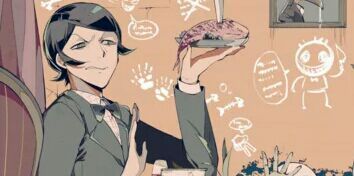
Having said that, I still do think certain aspects of the series could be changed to better appeal to myself. But again, I don’t want anyone to think that my opinion is more “correct” than what Kafka Asagiri himself decided for the series. This is literally just my personal thoughts on the matter, just like how if it was up to me Oguri Mushitarou and his slimy hair would not exist in Bungou Stray Dogs, even though, objectively, he’s fine and well written and nothing really needs to change about him, except I really want him to sue his plastic surgeon, and his hairdresser, like hello? Way to make a guy look unrecognizable, I guess.
Sorry, I’ll stop trashing on poor Mushitarou. I’m serious though.
The two major changes I’d make are the role of female characters in the series, and also the way that the concepts of self-sacrifice and “honorable suicide” are presented. I think these aspects are the biggest gripes I have with the story, but I also think that, especially in regards to the latter, the series wouldn’t necessarily be the same, or even “better”, if it was changed.
I’ve never really made a post going in depth about how I feel in regards to BSD’s female cast, but I’ve mentioned before that I think the fandom really underrates most, if not all, women in Bungou Stray Dogs. But in retrospect, I can’t really blame it all on the fandom’s general misogyny; the way that Asagiri portrays women in his story doesn’t really do anything to discourage the lack of appreciation for his female cast. The thing is that she’s almost always the side chick. She’s an accessory to hang off of his arm. She’s motivated solely by him, whether that be his goals, or just because she—and it’s never really explained why—is deeply and hopelessly in love with him. Who is this “she”? Who am I talking about, in particular? Literally every female character, barring maybe Yosano, might fit the descriptions I gave above. That’s how bad Kafka Asagiri is at giving his female characters agency.
It’s okay to have a character with a plotline that’s intertwined with another character. It’s okay to have a character that’s motivated by external forces. It’s okay to have a supporting character who doesn’t really do much except move the plot forward. It’s starts to become annoying when all of these characters are women, while their male counterparts get the better end of the deal.
Sometimes I hear people say that Kafka Asagiri is good at writing women, and I think, in response, that shounen anime has truly brought our standards down, six feet under the dirt where every interesting female character to exist in animanga is buried. Yes… Asagiri doesn’t shy away from writing female characters who can fight, and even, gasp! Fight well, but this is literally the bare minimum, especially for a magical setting that takes place in the modern age. Asagiri can create female characters with interesting traits and a lot of potential, then subsequently assign all of her traits to serve a male character’s narrative, while actively sabotaging any potential she had by utilizing her as a plot device.
And maybe I would be less annoyed if it went both ways. Kyouka has saved Atsushi quite a handful of times, why doesn’t he worship the ground she walks on and dedicate his entire life to helping her fulfill her goals? Actually, on this topic, the reason why is because Kyouka doesn’t have any substantial goals outside of being Atsushi’s sidekick for life. Now, I absolutely adore Kyouka and Atsushi’s relationship, found family is still my favorite troupe ever, but it’s noticeable that while Atsushi’s search for self-esteem and a so-called “reason to live” is the literal narrative core of the series, Kyouka, who had found herself struggling with a similar internal conflict, is by comparison, almost never explored further. When was the last time the story checked back up on Lucy, and how she’s feeling? Yeah, she’s in a better place now, but isn’t she still haunted by her years at the orphanage, under the Guild’s thumb, being treated like a pawn on the chessboard, just as so many male characters have been shown to feel in wake of their own traumatic experiences? Doesn’t she struggle to find a new purpose in life, now that she’s no longer stuck doing someone else’s bidding just to survive?
We only ever see a brief glimpse into the thoughts and feelings of BSD’s female cast, before the door slams shut, and they��re relegated to some background role where it doesn’t really matter how she feels, she just wants to help the guy who saved her life, that’s all we really need to know before we can start advancing the plot again. Well, I want to know more.
It would also be great to have more female characters who are motivated by something other than her desire to help or hurt another—oftentimes male—character. How come he’s allowed to delusionally seek world domination, and she isn’t? How come he’s allowed to desperately want to save everyone in spite of a cruel reality, and she isn’t? How come he’s allowed to be motivated almost solely by his selfish need for the validation of another, and she isn’t?
Which brings me to another avenue to consider: characters like Akutagawa and Rampo are shown to be fanatically devoted to another character, to the point that Dazai or Fukuzawa could say “Jump,” and they’d be in the air even before asking “How high?”. But here’s the thing: Akutagawa’s devotion is entirely self-centric, and it’s examined as such. He doesn’t selflessly want to help Dazai, no questions asked, he craves the peace of mind that Dazai’s affirmation would bring about, and consequently does anything he can to gain that validation. Not only that, but it’s portrayed as unhealthy and a problem when Akutagawa blindly does whatever Dazai asks of him, but somehow, this doesn’t apply to Louisa and Fitzgerald, Teruko and Fukuchi? Hmmmmmm!
Simply put, there’s a double standard here, and I’d like it to change, because BSD really does have a female cast with a lot of potential, if only Asagiri cared to utilize it.
***
In regards to Thing I'd Want To Change #2, I remember tag-dumping about this awhile back, but it somewhat bothers me that in order to pass the Detective Agency’s entrance exam, Atsushi and Kyouka were required to put their lives on the line to save another (even though, in Atsushi’s case, it was all staged). This might not have been a problem for me if the Detective Agency weren’t the good guys in this—or even if it was emphasized in some other manner that it’s OK to save yourself first, like c’mon, that’s just common sense, they teach you such in elementary school during a fire drill. But unfortunately, not only was Kyouka’s feelings on the matter never expanded on, Atsushi continues to believe that he needs to save people to deserve to live.
However, I do think that there’s still room for development here. Bungou Stray Dogs is not a completed work, so who’s to say that Atsushi won’t have a different outlook on life by the final chapter? Moreover, I think that in the situation where Atsushi first reached this conclusion (on the subway with Yosano and Kaji), Atsushi was probably in a worse mindset prior. For him, he felt that he wanted to live, but that he didn’t deserve to, so therefore, in order to justify his own existence, he grasped a “reason to live”, a motivation to not simply give up and perish right then and there, alongside a train full of innocent people. It was a very “in the moment” kind of thing, that would serve as a foundation for later developments. Again, I think it’s fine that this is his way of thinking now, but someone genuinely needs to tell this boy that it’s not a matter of “reasons” or whether he deserves to or not, living is just something we do without really thinking about it, so its okay if that he lives in that kind of unapologetic manner.
Still, the Detective Agency’s exam is kind of harsh, yet I don’t think it’s necessarily something I would do away with completely, as much as I would reframe it to better fit the message I would want to send. The thing is that working at a superpowered organization that regularly gets into scuffles with the local mafia is in no way safe, and your life insurance probably won’t cover it when you get magically killed and dumped in the river. So it is understandable if a minimum requirement for becoming a member is that you’re okay with getting caught in life or death situations on a semi-frequent basis. It may also be a desired trait that you’d be willing to rescue civilian lives at little benefit to yourself, though not necessarily always in the context of self-sacrifice. Sure, it’s a crazy way of interviewing for these attributes, but it’s not like people don’t lie on their resume, and also, the Detective Agency was established early on to be full of crazy people. You must be this bugfuck insane to join, if you fail the vibe check you die, sorry!
In all seriousness, I think the concept of living, and in particular, having a reason to live, are a major part of Bungou Stray Dog’s themes, and changing it to suit my own opinions better would probably drastically uproot whatever message Asagiri wanted to send, whatever feelings and opinions of his own that he injected into the characters of Atsushi, Dazai, Kyouka, and the like. Even if I myself do not fully agree with the narrative, I still think its okay to have media that tells a different feeling, shares a different experience, and presents a different opinion.
Anyway, this got really long, sorry I was too lazy to include many embedded pictures to break up the text walls. If you read this far to the end then I appreciate and love you dearly, hopefully I made some degree of sense and didn’t just sound like I was rambling out of my ass.
#bsd#bungou stray dogs#dazai osamu#nakajima atsushi#akutagawa ryuunosuke#izumi kyouka#lucy m#bsd women#bsd meta#bsd analysis#anonymous#answered
32 notes
·
View notes
Note
ALSO CAN I ASK FOR SOME RANDOM GOM HCS U HAVE? like just random ones u have or if u want like some toxic hcs abt them :D
I’m assuming that I can include their negative traits of their personalities as well 👀 Also including Momoi in this… lots of analyzing for this hc, so I used my brain here pls appreciate AGAIN these are all headcanons/interpretations of possible toxic hcs about them and only a few are canon
[Headcanons]
Kuroko Tetsuya
Kuroko is the hardest person to find a “negative/toxic” trait in, and it doesn’t seem like he has any
kind, understanding, hardworking, and compassionate; he’s everything a good-natured protagonist is
but he’s only like this to people/hobbies he cares about/close with; anything else he’s quite apathetic and also very passive/neutral about
the biggest hint to this is when Akashi criticizes Kuroko for cherry-picking who the GoMs should “go all out against” and who to casually toy with
and Akashi is absolutely correct
most of the series is portrayed through Kuroko’s perspective, and Akashi is the first direct outside perspective who comments on his actions/attitude
it’s obviously not that Kuroko didn’t “notice”... he clearly sees and knows what these GoMs are doing; after all, he had a conversation with Aomine about how observant he is to everything around him
of course, if you were close to him, all your opinions and issues matter to him
it’s the fact that what’s not really important to him is suddenly now important just because someone he knows is involved
just an example: if someone was advocating climate change, he has no opinion on it until someone he knows cares about the issue
in other words, he has a subtle hypocritical view on things, especially when he interacts with others
another clear negative trait could be that he’s too idealistic or perhaps naive, seeing things in a clear black-or-white picture and not necessarily a gray area
WE know, as an audience, that the GoMs honestly needed therapy and a proper adult to guide their out-of-control talents
but Kuroko, in his eyes, had viewed them as “bad” and “evil” in their ways of basketball until they changed after their respective matches
he’s probably someone who doesn’t yield to other opinions once he forms his own, and this may make him unable to consider things in other people’s perspectives
which is again, ironic: someone who doesn’t have generally a strong stance but once they do, it’s very unyielding, which further proves Akashi’s comment about Kuroko’s tendency to nitpick which to care about
a final hc about a potential flaw he might have here in a different ask!
Kise Ryota
y’all… it’s as canon as day that he has a mean side
straight from the author himself, it’s confirmed that Kise is only kind to those who he respects, and to the rest, he’s cold-hearted
in the manga, it’s very clear that he’s super judgmental on every first impression on people he meets, boxing them into categories based on the way they look, act, and speak
only when they surpass his preset expectations (low or high depends on his preliminary judgments of them) is when he opens his mind to the rest of their personality
this is a very close-minded way of thinking, and I hope I don’t need to explain why LOL
this can be interpreted as him being two-faced by the majority of the people in his school
his way of speaking can definitely be very cruel and crass, and to sensitive people, his words can easily shatter hearts
Kise’s negative/toxic traits are pretty straightforward here, so let’s move on
Midorima Shintarou
his harsh words can be considered a “negative” part of his personality, but I think it’s a lot more than just that
it’s confirmed in the series that he’s a bystander and almost always minds his own business
on one hand, one can say he’s self-driven and that he constantly strives for self-improvement
on the other, it can be interpreted as him being very dangerously ambitious and selfish, in which most actions he takes are for the sole reason of self-improvement and not for altruistic reasons
for example, when he helped Kuroko and Kagami in the training camp, it was under the reasoning that them becoming stronger would be a good challenge for himself to test and learn
that’s not to say that he can’t have friends, but most friendships he’s built are with capable people who can potentially provide him with some new beneficial skill/goal to strive towards
after all, he’s only learned to trust Takao as a friend only after seeing him as someone capable
because he’s so focused on himself, he’s extremely likely to turn a blind eye to injustice, most also likely to use Oha Asa to justify their “misfortunes” as he continues on his day
he’s not cold-hearted, but altruism comes by Midorima a lot rarer than the average person
now, we know that his Oha Asa aspect is used to balance his serious side as the “comedic side” of him, but if we really think about it, his obsessions with the horoscopes could be a huge obstacle in the future, where he may refuse to listen/depend on others in favor of his own intuition and the stars; after all, no one knows everything, and depending on the stars as one’s next source of advice and guidance isn’t a sound decision to commit themselves to
he seems like the person who overthinks and jumps to conclusions when it comes to social situations, but instead of confronting the person, he turns to fate and fortune if Takao isn’t near to help
Aomine Daiki
I wouldn’t be surprised if Aomine had a skewed sense of beauty standards from all those magazines he consumed and from being around Momoi for the majority of his life
of course anyone can distinguish pieces of media from reality, but during the most impressionable years of life, without experiencing other types of people and physiques, he would have limited knowledge on what “beauty” is and whatnot
this probably would be more of a problem in his adolescence than adult
a very given negative trait is his short temper plus his tendency to turn to physical violence when someone nags him to a certain point, seen with how he’s treated Wakamatsu in the beginning (though this seems to almost disappear by the end of the series)
what I’ve noticed in every scene he’s in, is that everything seems to revolve around him and his hobbies of basketball and Japanese idols
what I mean is that everytime we see Aomine, it’s always Momoi approaching to Aomine or just him always being the center of attention; never once has he approached Momoi for anything and it’s always been the other way around
in other words, people have to cater to him in order to get along with him/be in good graces (additional example: Imayoshi letting him do as he pleases to get him to be cooperative and participate in the games)
we’ve actually never seen Momoi’s hobbies outside of being a manager for her basketball teams and just anything basketball-related
he can be quite apathetic, choosing to only pay attention and try in things he’s interested in… which is basketball and those magazines
he seems to mature in the Last Game though, so I’m not quite sure to what extent these headcanons would apply to older Aomine (these also don’t really apply to Puremine)
Momoi Satsuki
the author probably also included this type of anime trope as comedy, but belittling another female for her body is definitely a no-go in reality; I feel like this is something most people gloss over really lightly
her body comments on Riko are actually what made me skeptical of her character at first before the show really shows her entire personality
that being said, it seems that she always takes the opportunity to look down on other girls (especially to those she is a stranger to) as a sort of “competition” when there’s boys around
definitely at certain moments, she screams a “pick-me girl” type of person (real phenomenon, you can search this up!)
while Kuroko doesn’t seem to actively mind this, I think she also has no good sense of boundaries and what’s considered appropriate touch and consent; people can chalk this up to “oh it’s just infatuation,” but this definitely isn’t okay if we really think about this
her life also seems to revolve around either Aomine or Kuroko, and based from that, I’d feel like she’d have a difficult time forming her own identity/life separate from her “manager life,” especially once she graduates from Touou
can definitely be interpreted as too clingy at certain moments, while others may think it’s her way of showing that she cares
Murasakibara Atsushi
most people would chalk up Murasakibara as “lazy,” and on the surface level, it does appear to look that way…
I think his true negative trait is that he has a lack of intrinsic motivations to drive him to do things
it’s different from being lazy; someone can be lazy while still having a goal, and certainly someone can be lazy while they’re motivated by thoughts of “I want to learn more,” “I want to get stronger,” etc. (you guys, it’s me right now in college)
and he doesn’t have that
part of this was contributed to the fact that he’s already so gifted with genetics and thus, there’s never been a goal for him to have to work towards to when he’s already at the top
he doesn’t actively seek out, and while that may be a characteristic of sloth, it’s not exactly right either
he willingly does things if people around him give him the motivations/reasons to do so; a person of sloth wouldn’t do anything even with all the motivations and goals handed right to their face
snacks/food are examples of extrinsic motivations that fuel him to carry on daily life
Himuro is always the main motivator for Murasakibara to come out and watch matches, and he also does whatever Akashi orders in both Teiko and present days // a person who can give the giant the motivation to do tasks would get along with him the most
searching out for a challenge against his basketball skills is something that’s never crossed his mind
why? he grew to be like the way he is because of the lack of results from his “search” of a challenge throughout his games
again, it’s only when Murasakibara gets handed a silver-platter of a challenge, Jason Silver, that actively gets him pumped up and raring to go
as such, Murasakibara is equivalent to a rusty machine, extremely difficult to start up and find compatibility with, but very powerful and efficient once he finds that spark
Murasakibara finding any partner or friend in the future would be extremely difficult because he ticks a different tune from the rest
Akashi Seijuro
his entire Bokushi side was a giant-ass red flag for very obvious reasons LOL anyways, moving on…
it’s difficult to pinpoint a negative characteristic for Oreshi because he’s the pinnacle of a gentleman character… but that technically is also his negative trait
for him to maintain that perfect image for himself and others, he has always carried himself in such a way that doesn’t allow for errors or expressions of “weakness”
thus, bottling up his frustrations and emotions to the point of no return is something very familiar to Akashi, and I’d feel like Bokushi is the result of his overflowing emotions left unchecked in the first place
I also predict that if Akashi continues to carry himself without letting himself wind down and feel emotions on the spot rather than locking it up inside him, a day will come when he splits into two halves again with a “new” Bokushi to deal with his current life (and let the current Oreshi take a backseat in his psyche to take a break from the turmoil)
also will tend to overwork himself to manage people’s expectations as well as his own, and he’s not one to depend on people not because he sees them as inferior or incapable, but because he’s doing this out of habit from being in positions of authority and responsibility for much of his life
and so, he may tend to hide important things or just not speak about his problems in general to those close to him because he feels like he can do it all himself and spare everyone the work and stress associated with them (a leader mentality)
throughout the majority of his life being calm and calculated, his emotions would definitely escape from him in forms of uncontrollable lashes of anger… before he would realize what he’s done… that is, assuming that another Bokushi hasn’t form within his subconscious yet
#knb#knb headcanon#knb headcanons#kuroko no basket#generation of miracles#gom#teiko#teiko middle school#knb teiko#kuroko tetsuya#kise ryota#kise ryouta#midorima shintarou#midorima shintaro#aomine daiki#momoi satsuki#murasakibara#murasakibara atsushi#akashi seijuro#akashi seijirou
305 notes
·
View notes
Text
Why Genshin’s Summer Odyssey Mirages are amazing
I’ll do this once I finish my work!!
but here’s the rough draft:
What kind of game is Genshin Impact?
Genshin Impact is a well known game per 2022. Personally I don’t play so many games outside mobile gacha and pixel ones, but I can say for certain: Genshin is an anime gacha game, get over it. It was developed by a developer known for this genre, and since I’ve played several anime gacha games before I can tell based on the characterization, grinding, wishing, and events system this is where Genshin belongs to. However, a big HOWEVER, there’s one thing that separates Genshin from the rest: the explorable world. This is also where people compare Genshin to other open-world games, but since Genshin was born from anime gacha game it makes it has no competitor overall. It’s an anime gacha game by system, executed like an open world games.
As months passed by, Genshin also finally shown its good and bad. There are many, many things need to be criticized in this game, but in my opinion there are also some aspects that always delivers in every patches. The first is music, Genshin music is very top notch and using real orchestra, imo it’s hard to make real orchestra flop. And the second, the one I’m more confident to breakdown: the worldbuilding. I wouldn’t say Genshin’s worldbuilding is unmatched, but it’s definitely up there, SS tier. And this is circled back to my previous point: Genshin is a different anime gacha game. Many gacha games have great world building and lore already, my favorite is Fate/Grand Order and this is how they presented it (VN style). Genshin Impact, notable as the first open world anime gacha game has more freedom to express their worldbuilding. How they do it? This is what I’m gonna breakdown here.
This is a Genshin Impact worldbuilding appreciation post!
The space as a media
Firstly, I’m not gonna explain about how they have cultural or whatever inspiration, here I’ll more dive on their spatial use & composition. What’s this spatial thing anyway?
What I mean is “space” as a media, no, not that kind of outer space. People with 3D design or architecture background maybe already familiar with this. Well, imagine a blank canvas, then an artist draw something over it. Whatever genre they did, everything must have a composition. What is composition anyway? The easy answer is “placement”, how to make things look good on the canvas. The artist will decide where they gonna put this most important blob, where to leave the canvas empty, etc. They may make abstract, or impressionism, or even anime art, but the composition is always there.
Now imagine a 3D box, you have the whole box. There are X, Y, Z axis formed a volume inside the box and you can do whatever you want. This is, the volume, is the “space”, the media to pour your imagination. Well this isn’t the most correct definition but I hope you get it. Let’s talk about it in Genshin’s manner!
If we visit Inazuma (since this is the most advanced spatial design of a region so far) there are obviously grounds and skies. In this hilltop (image of a hilltop) we can see the ground, sky, sea and Inazuma’s unique thundering(?) device. These components formed into a composition in a 3D space, while the Japanese aesthetic and inspirations are “just” the genre. How about spatial use?
This is where things are getting interesting. The user of this space are us, the player, or more specifically whoever active character we pick on field. Spatial use means how is this character gonna occupy/exploit/experience the space? What kind of exploitation can be performed in a space?
We have 3D space, means our character will not only walk back and forth. We can make them go higher, or lower. We can alter the gravity so our character will float in air, or walking upside down.. et cetera.
In this Inazuma landscape we mainly use the space as we did in real world, unless for that thundering thing. That thing can move our character swiftly in the air, and this kind of thing’s nature is what I’m gonna explain here.
How Genshin Impact plays around with space
Genshin Impact is an adventure game, so a space isn’t a mere place to settle. The easiest logic of space exploitation/experience is just how far our character can get into? Try to watch several “domain-breaking” videos, it’s basically apparent how the dev wants the player to experience the space: to make the surface walkable. If it isn’t, then you’re playing the game differently from the dev’s intent.
The open-world part of Genshin is easy to understand. It is mainly just like our earth with normal gravity, normal ground, normal walls etc.. maybe just their shapes are weirder. The unusual ones are usually the devices to go higher, like wind currents, thunderbolts, windy stones in The Chasm..
The domains, however, has many unique mechanism that can exploit a space differently than before. It’s already apparent ever since 1.0, in earlier domains (personally I like Lisa’s) but they barely develop it until this Summer Odyssey patch (I think), the four unique domains in this event are so amazing! They’re so different with what we’ve encountered so far, and I mean to the spatial sense too!
To make things clear, of course Genshin isn’t the only one who did something like this. Plenty of movies and games already did this as well! For example in the movies: Dr Strange and Inception. Look at how they alter the space so people can do activities in unusual areas. As for games, the recent Stray game is one prime example! Look at how our understanding of space became different when we turned into a cat.
The Summer Odyssey Mirages
Why I’m emphasizing Summer Odyssey Mirages so much?
Well, this is the first time in my opinion Genshin Impact really make use of their 3D freedom to make great storytelling. In short, finally Genshin found a unique way native to Genshin only to tell the lore of the game better. Why I can say for certain like this? It’s not like Genshin is the only 3D game. Yes, but for the current anime gacha game, it is.
So far, I think Genshin is struggling to retell the vast lore of the game in form of playable storyline. They’re scattered everywhere: in characters’ pages, artifacts, books, item descriptions, weapons, etc... and who the hell gonna read all of that except for some lore maniacs (I’m not even one of them) while some infos stated there are important. I never skip dialogues, yet I still missed big chunks of info since I don’t bother myself to read most of them.
Most anime gacha games tells everything in their VN style texts. That’s why maybe for some people they don’t think Genshin’s story is that deep, because what we’ve experienced in-game are minimal compared to things like these:
HI3 Logs
FGO logs
AK logs
See, they are able to put everything in paragraphs and no one will protest, cuz that’s how their game format is. Genshin, however, is not. Try to read these lore dumps: (Inazuma aftermatch), very unentertaining amirite?
Thankfully, Genshin’s nature of the game let them go beyond mere texts. While it took way more effort and time, a spatial experience can be a good way to tell a story. And this is what Summer Odyssey Mirages are. They are domains to tell stories, by letting the players experience the space.
They positioned the components of story & lore in a 3D space that can be perceived by visual and hearing. It feels like you’re experiencing the story yourself, and not only the visible/tangible aspects incorporated into the domains, but also the intangible ones like emotions. You can see in Kazuha’s the house looks more and more a run down as we progressed there just like his state of life.
This is not something you can experience just by watching videos, watching your friends play nor read theories. You gotta do it firsthand. This is exactly why I’m keeping on playing this game.
I’ll try to go analyze each mirages in the next post based on my understanding. I do have some knowledge of architecture but it is just a surface, so if anyone wants to add or criticize something it’ll be very appreciated! Thank you and see you later.
welp it’s getting harder, let me boot my brain first
#genshin impact#lol what the XD#but i really like this subject and i hope i can tell what's inside my brain =_=#i can write a fking thesis with this LMAO
4 notes
·
View notes
Text
Japanese Crime Boss Character
@picture-of-dorian-gray asked:
I have a crime boss supervillaintype character who I wanted to make Japanese American. He gets superpowers which start a redemption arc for him, and will eventually be a hero or an antihero. It occurred to me that I might be playing into a stereotype with the crime boss thing. It wasn't going to be Yakuza or anything, but should I reconsider making him Japanese? I feel like there are a lot groups that are stereotyped as criminals but also I didn't want to play into the white crime is cool thing.
Characterization
It depends. Are there other Japanese characters besides just him? Are all the “good guys” white? Because having one Sketchy Japanese Crime Boss Guy in a cast of well-developed Japanese characters would be fine.
But if he’s the only Japanese character… then yeah. You might want to question why you decided to make him Japanese, and not anyone else. Because “it’s just the way I imagined him” isn’t a good enough answer. Try to think about your creative influences. Are certain aspects of him based on another fictional character? Or on troupes you’ve heard about through pop culture osmosis? I’m asking you this because a lot of content creators inadvertently perpetuate racist stereotypes, whether or not they mean to. While you can still appreciate the good stuff that those content creators do, you need to know when their racism might be influencing you, and think critically about the things you read.
Now, about the redemption arc.
Redemption arcs are becoming more and more popular these days, especially in animation, and having a character with a redemption arc won’t automatically make your work good or a profound statement about human nature or anything. In order for your redemption arc to be compelling, you have to make sure that it’s paced properly, and you have to create a believable situation where the Sketchy Japanese Crime Boss Guy gradually realizes that, based on a part of his own worldview, he has a reason to change his behavior.
Also, keep in mind that understanding you need to change, and actually changing, are two different things. If you’ve lived a lot of your life one way, then realistically, you won’t switch to living another way overnight. So showing gradual, believable change, even after your character knows that what he’s doing is wrong, is important.
Also, if you’re not Japanese yourself, or at least an expert on Japanese culture, I don’t think it would be a good idea for you to have part of his redemption arc be based on rejecting his heritage. I mean, I don’t think you were planning on doing that anyways, but I just wanted to warn you.
But yeah, it depends. —Mod Ixia
199 notes
·
View notes
Text
One Piece Animation Thesis: East Blue

If you would prefer to follow via the master Google Doc, [HERE] is the link! This will be updated as we go through the arcs and is currently planned to be updated weekly!
------------------------------------------------------------------------------
Whew hey everyone!
So this is the beginning of a project that I have had in the back of my mind for quite some time and finally decided to start working on. A quick rundown of what this actually is, it’s a somewhat showcase of the animation found within the main One Piece anime (so, no movies/specials/filler arcs between canon arcs etc. although that may be something I will attempt to tackle one day if this does well). This will also include some insight into the anime industry and essentially give some insight on behind the scenes and why certain decisions are made as well as giving names of the hard working animators to their respective scenes. Hopefully this whole thing will continue to give a bit of insight into the One Piece anime as I believe that it is greatly under appreciated and while criticisms of it are valid, there definitely needs to be more of an understanding as to why the anime is the way it is. This will be a long journey ahead so please bear with me! Let’s get started!
The One Piece anime, including movies and specials, is animated by Toei Animation, and they are responsible for many other famous animated properties and adaptations, including Digimon, Dragon Ball/Z/GT/Super, Sailor Moon, Toriko, Gegege no Kitaro among many others. They animate many different series and have a big load to take on. This is something that will be touched on later, because it greatly affects the anime in later years. But for now, I’ll be going through the arcs, starting with the East Blue saga. The East Blue saga is made up of episodes 1-53 (including some filler) and consists of quite actually not that many noteworthy animated scenes, even though it covers many arcs (Shells Town, Orange Town, Syrup Village, Baratie, Arlong Park, LogueTown). Animation throughout this portion of the anime was quite limited, using minimal movement and taking appropriate shortcuts where necessary. Scenes are also quite hard to tell exactly who animated what due to the style consistency. There are a few noteworthy scenes though, but first I would like to introduce the rough structure of how the anime is made. An important part in animation is someone who is the character designer, someone who essentially designs the characters and in this case, attempts to replicate Oda’s style for it to be easily animated. During this part of the anime, the character designer is Noboru Kizumi who would continue to be the character designer for the anime for the next 10 or so years. These are the some of the sheets he made for the main characters:

This is something I’ll continue to showcase as we continue to go through each of the arcs, showcasing the strawhats as they pop up in the story. When the time comes, we will also compare the changes of style and why things have changed. But for now, I’ll just present the first designs.
One Piece at this stage was very cartoony and had quite a different style, especially compared to a lot of the current anime/manga at the time and it still continues to have a distinctive style to this day. Following these sheets allows for a good sense of continuity, which is very important with anime. If anyone out there attempts to draw something without looking at a reference, it’s not going to look quite as well as we want it to. So in using a reference, we can have a better grasp as to how the character looks from certain angles, heights compared to other characters, facial expressions and more.
In order to keep these characters looking somewhat similar so as to not disrupt the viewer’s experience by seeing jarring styles, someone works as a Chief Animation Director. They aim to ensure that characters remain consistent throughout the episode, and that they are on model. So, how is this achieved? Well, we’ll have a look at the process on how something is conceptualised and then put to screen.
Initially, a script is conducted. Going through the manga, people take what is deemed necessary material and put it into script format. It is important to note that as the anime and manga continue to go on for years, the gap between the anime and manga release shortened significantly, resulting in pacing issues. Keep this in mind for later as this is something I plan to touch on. Then a storyboard is created, having very rough lines in order to convey what is to be created. Here is an example:
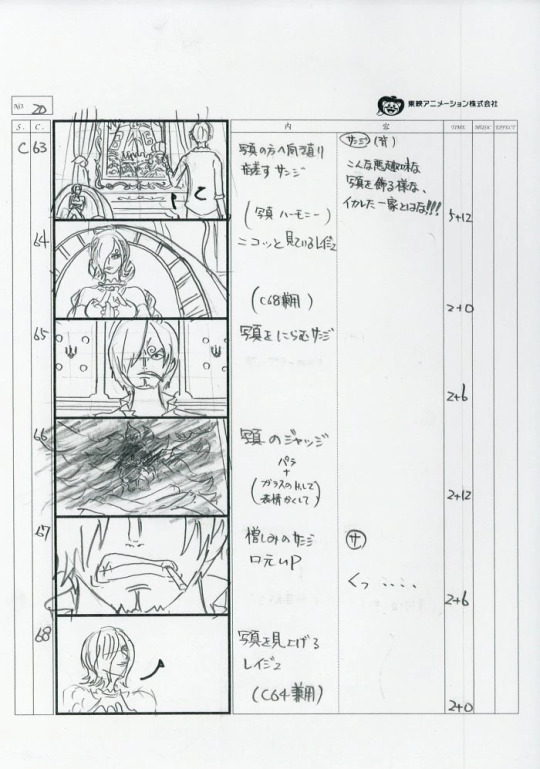
A good storyboard can make or break an episode, as it dictates angles, how long scenes linger on screen, etc. Once the storyboard has been decided on, the animating can begin. Scenes are appointed to animators, where they create something called Genga. This is done on paper, similar to how it’s done in other parts of the world. Here are some examples of older Genga:
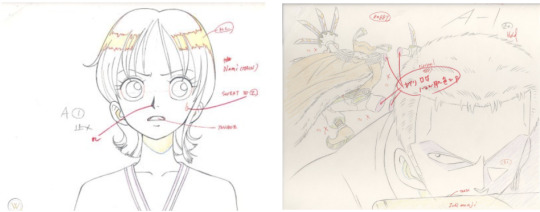
Even though times have changed and anime has become digital, with some animators now exclusively animating digitally, the anime industry still uses Genga, using paper and pencil to create their scenes. Here are some examples of newer Genga:

Once the Genga has been created, the Chief Animation Director will go in and correct what is necessary to ensure that the style remains consistent. Others may also help participate in this process, such as an Animation Supervisor. Here is an example of a Genga being corrected to ensure that it remains consistent in style:
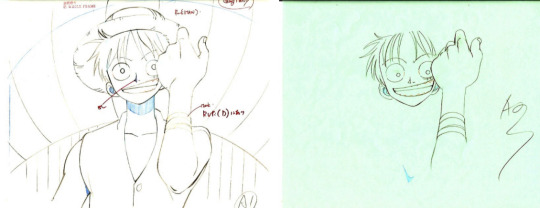
In doing something like this, some animators can animate great action and keep their lines rough to save time, and an Animation Supervisor can clean it up and make it look good. After this has been completed, the Genga is then made into what is called Animation Cels. This is not exclusive to Japan, as for decades this is a process that has been used. This is a transparent sheet that had the lines and colours painted on, and is then photographed over painted backgrounds. Yeah...A long and dubious process indeed. This is not common place anymore due to how time consuming it is, and with the rise of digital, creating colours, effects, filters and backgrounds are much faster and easier to accomplish. Here are some examples of One Piece animation cels:

I would have much preferred to share cels directly from the anime itself and not the movies but they are quite difficult to come across and have more than likely been sold off from Toei long ago. But they will suffice, as it gives a good idea as to what they look like.
But voila! Animation has been created! All that’s left is music, sound effects and voice over and you’ve got yourself an anime. Wonderful. Easy right? Yeah, not exactly. All of this takes time and patience. And this is something that needs to be remembered. Time. A very important keyword in the animation industry and a lot more important than the word budget that likes to get thrown around. Due to One Piece being a long running weekly series, the animators have a lot less time than, say, My Hero Academia or Demon Slayer, two very prominent seasonal anime. These series do not have more money shoved into them, more budget, than One Piece that results in higher quality and consistent animation, a problem the One Piece anime definitely faces further down the road. Here’s an example:
Michelangelo is one of the most famous artists of all time, due to his remarkable attention to detail in his works present in the High Renaissance period. One of his most famous works is the Statue of David, an incredible piece of work that was worked on for 3 years. However, if you were to tell him to replicate it but say, give him a month, he’s not going to get anywhere near the same results as the piece where he spent 3 years on. It would be quite rough around the edges, and quite rushed. No matter how much money you throw his way, he still won’t be able to get anywhere close to those results. And this is the same with any artist, including animation. This is a big misconception in the anime community, and that is that as long as you throw money at people, they’re going to end up creating incredible works, regardless of the poor time management. That is just not how it works.
This does seem like quite a ramble, and it’s already quite long prior to even reaching the main aspect of this whole project, in which I showcase animators, but this is important background information that needs to be understood prior to delving in. With that very long introduction, let’s now get to showcasing animators!
Some of the animators that were present on many early One Piece episodes include:
Kazuya Hisada, Masahiro Shimanuki, Naoki Tate, Jin Inaba, Tadayoshi Yamamuro. Please note, there are many others involved animating wise, but these are some key names, and ones that will develop and evolve as the years go on.
Kazuya Hisada is someone who will pop up later and fulfil a more important role in the series, but in the early days he created some great scenes with some snappy timing, while using lines to help convey impact. He is found throughout early One Piece, however due to the limited animation and consistent style thanks to Noboru Kizumi, he can be difficult like most during this era to spot.
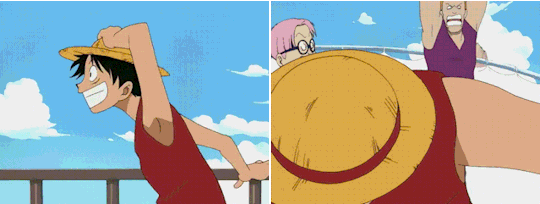
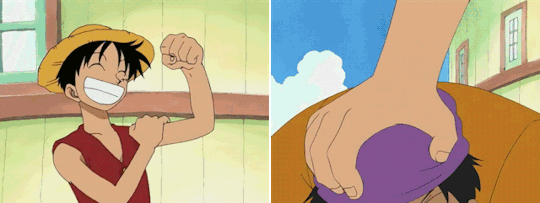
Hideaki Maniwa is more prominent in his animation, being more pronounced due to his camera movement on his characters. He uses subtle smears usually on impact to further enhance the idea that whoever is being hit, is being hit HARD. He also created the most animated piece of early One Piece in episode 23 where he creates seemingly natural movement of the background of the ship and water, making the sea feel powerful and heavy.
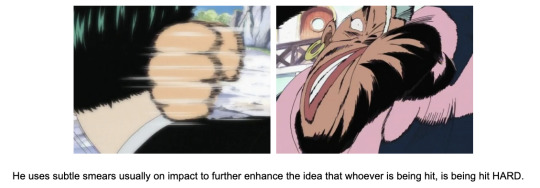


So what have we learnt so far.
Well, there is a lot of hard work that goes into the production of an anime series, and that is no different with One Piece. Early episodes for the most part had not too many interesting scenes animation wise, and the animators essentially got the work done in order to produce and release the series week to week. It will continue to be a bit of a slow start, with arcs like Alabasta and SkyPiea being similar in the regard of not many noteworthy scenes however, we can begin to see the cracks of emerging stars and evolving styles that will later become staples within the series.
This is it to the first of what is hopefully a long and engaging project! So far it has been quite a read and very lengthy and I apologise for that. Hopefully from here on out we should be able to successfully get through more animators and styles become more distinct and animation continues to evolve. Next up I intend to cover Alabasta.
------------------------------------------------------------------------------
A massive thank you to everyone who has participated and uploaded at Sakugabooru! Without it, I would not have been able to make nearly as much as I have without all the hard work in identifying and tagging animators’ work! Most of the footage used to showcase these animators has come from there! I simply just turned the videos into gifs for an easier showcase.
I would also like to issue a big thank you to Animators Corner! The staff listing really helped me in determining who worked on what episode to identify animators and their works!
#one piece#anime#opgraphics#gif#if you could please share this!#would love for this to be spread thank you!#op animation thesis
230 notes
·
View notes
Text
So, because Fatou’s season ends today and, as far as we know, Druck hasn’t been renewed yet, I want to go over the things I feel the team did well in this season and the things I hope they take with them when they sit down to write the next season (which I’m manifesting will be Ava’s).
I think that s5 and, perhaps to a bigger extent, s6, were the team’s attempt to address fan feedback for and criticisms of s3 and s4. So I have hopes that, after possibly the most scrutinized season of any Skams, they are still willing to read even more feedback and sit down once again to craft a couple more seasons (possibly even 3 or 4 more seasons!).
So, without further ado, things that were done well! (Do I have to add “in my opinion”? Do I??)
I liked that for both s5 and s6, the thorough-line for the season wasn’t made obvious or shared in a press release, but rather it was up to fans to connect the story threads for themselves.
I loved that the team sought to address one of the biggest criticisms of s3, that is, that Matteo was given so many symptoms of a mental illness, but it ultimately went unaddressed in the narrative. They did this by giving Nora a dissociative disorder, and Fatou dyscalculia. (Matteo has been headcanoned as being mentally ill and having a disability.) It allowed the teams to develop both fan theories into full-blown seasons and give each of them the importance they deserved.
I have said this already, but I really appreciate that the team chose misunderstood, misrepresented and underrepresented mental illnesses and disabilities. I feel like s5 and s6 will be referents for many years, because they really took the time to portray a dissociative disorder and dyscalculia in a down-to-earth, unhurried way that isn’t meant to shock and awe, but simply allow us to understand why and when Nora and Fatou will struggle. Druck got the viewers to anticipate when Nora and Fatou would struggle, and that’s the first step in being able to anticipate and accommodate the needs of the Noras and Fatous of the world. I really can’t overstate how important this is and what a difference it makes in a real, tangible way. These seasons aren’t meant to be enjoyed for voyeuristic reasons, but they will legitimately help people.
One of the biggest criticisms of s4 was that Amira and Sam didn’t connect as women of color. In fact, it seemed like in s4 Sam was treated as another white friend, when in s2 both she and Amira were the victims of Kiki’s racism. The team addressed this by giving us Ava and Fatou’s friendship, which I want to say might be the first friendship between main characters of color where their race is a substantial reason for their bond. (There are the Sanas with their Jamillas, but the Jamillas aren’t main characters, and then there are friendships like Jo and Megan and Zoya, or Imaan and Liv, or Luca and Yasmina, but iirc in every case their bond as women of color isn’t made explicit.)
Another criticism of s4 was the way Kiki turned into the world’s most understanding white friend offscreen. The team addressed this with the Ava and Mailin storyline, which I think was wonderfully and subtly set up in s5, then built on with the biology test leaked answers.
On the topic of race, I think a major criticism of s3 was that David’s ethnicity wasn’t acknowledged (to the point where a white actress was cast to play his sister gvhvhv). The team has made up for this with Josh (more in the s6 sm than in s5, but I still count it) and with Kieu My. Fatou and Kieu My bonded over being first/second gen children of immigrants, and in doing so, they acknowledged that these characters aren’t white and have different experiences than white Germans.
The first 6 episodes of this season were some of the finest writing in the Skams. The storylines all connected and built on each other. The motifs were just so good and beautiful and fitting. The themes were all clearly defined and easy to follow.
The tortoise plot was one of the most fun and imaginative storylines in any Skams, it connected Fatou and Ismail in a believable way. And not to rave about a fucking tortoise, but animals can be really uncooperative and that tortoise delivered every fucking clip. Druck has a reputation for being one of the most depressive versions of Skam, but the Maike/Burger plot was just plain fun.
I feel like some of the old gen’s instas were a bit self-indulgent. I’m thinking specifically of Matteo’s memes and how they they weren’t necessarily the kind of memes a gay dude born in 2001 would pick, but someone a decade older. I think this is much better done with new gen. Fatou’s memes reflect her age and her sexuality, and not just that, but Ava, Mailin, Kieu My, Josh, etc. all pick memes and even focus on different aspects of recent news, based on their gender, race, personalities, interests, etc.
I appreciate that the team found a way to fit a sex scene between Fatou and Kieu My to add to the small catalogue of wlw sex scenes on Skams (I’m including the scene in lovleg or we’d only have two lol). While I understood the reasons eskam opted not to include one, I thought there were ways to feature a sex scene that didn’t sexualize the actresses and didn’t require nudity. Cases in point: the lovleg scene, and this scene in Druck.
And it also needs to be said. This is the first original season with a main of color, and the third season overall (after Liv and Imane) where 10 episodes are given to a character of color and no one else. Of the three, it’s certainly the season that loved and respected its main the most. The bar is so low it’s in hell, but Druck did clear that bar!
With all that said, let’s talk about the things I would really want the team to address in following seasons:
The thing I most want them to fix might be small or unimportant for a lot of people, but I think it’s at the core of why the season has been unenjoyable or certain plot points haven’t come across the way the team wanted, for many people. I am talking about the overly expositional nature of the writing. It appears as if the team approached the writing of the clips with the intention of hitting each beat as noted in their agreed upon outline, and absolutely nothing else was to be added. This is an issue both in s5 and s6. It’s just less noticeable in s5, because s5 is setting up stuff for Fatou’s season, and possibly even seasons that haven’t been written yet. The fact that absolutely every second counts makes for a stressful watching experience for me, because the narrative tension is always heightened. Whereas with Skam, the narrative tension would build throughout the clip. Take the Pride scene in Skam, for instance. The clip allows for Isak and Eskild to get increasingly more agitated as they butt heads. I feel like if this Druck team had done the Pride scene in s5 or s6, the clip would’ve started with both Isak and Eskild already on edge, and cut much of the dialogue that got them there.
On the topic of naturalistic dialogue, this season doesn’t have it. Here is an example from ep 10 clip 2, Wieder vereint/Reunited 11:37.
Fatou: I’ll get a certificate too and bring it over to you. And I checked it, I only have to change one course and my schedule will work.
Teacher: Miss Jallow, you are not the first one to come to me with an epiphany. We could fill entire school weeks with the lessons you missed. In addition, Doctor Steinberg told me about your, well… activities. You don’t have a lot of arguments on your side.
Fatou: But I’ve spoken to all of the teachers and they said they are okay with it.
Teacher: You seem to have friends among the teaching staff. Mrs Pavlovic put in a word for you. Okay then, do it and go before I change my mind. [translated by @kieu-tou! Thank you!]
Like. This is the bare bones version of a dialogue. This should be the first draft, not the final version. The coordinator goes from absolute no to yes, with just one line from Fatou. The coordinator gives reasons that would necessitate more than one sentence of counterargument, like Fatou’s absences and the Biology test leaked answers. The coordinator even says Fatou doesn’t have a lot of arguments on her side, and yet it takes Fatou one line to change her mind!
And of course we viewers don’t want or need a lot of time with the coordinator. And particularly at this point in the season, no one would enjoy a naturalistic dialogue with the coordinator of all people. But my point is that this is an issue with the dialogue all this season (and last season as well, but this season has been more scrutinized), the reason I picked this example is because of how easy it is to see here.
Which brings us to the pacing of the clips, and specifically the Friday clips. Because the script goes straight to the information the team wants to convey to the viewers, skipping the build up to it, many Friday clips have fallen flat, felt abrupt, and have been, tbh, unsatisfying. Again, I had this issue in s5, but as that season went on, I felt like the team had a better grip on Friday clips. But then they did it again in the first Friday clip this season, and so I think this is something the writers really should work on. The first Friday clip in Isak’s season closes on Isak being sandwiched by Emma and Even on a bench, visually setting up the love triangle, or more accurately, the personifications of who Isak should want to hook up with and who he really wants. But in order to get there, we’re shown a good amount of info, from the way Vilde, Eva and Sana are handling Noora’s absence, to Chris and Kasper, Even hovering around Isak, Emma trying to impress Isak, Isak escaping and, like, draping himself on the walls because he’s so over it all. Isak playing a game on the bathroom to stall for time. The paper towel maneuver to immediately give us a sense of what a weirdo Even is. A conversation between Isak and Even that gives us some clues about Even’s shame, as well as establish interests in common (like weed), and this is all before Emma even joins them! Just think of all the stuff we learn about who Isak, Even, Emma, Eva, Vilde or Sana are as people, before we get to the point of the clip! Fatou’s season simply didn’t have that. Compare it with the first Friday clip of Fatou’s season where the cashqueens quickly talk about the leaked answers, one of the major storylines this season that only gets a couple lines, before Fatou says she doesn’t want to talk about school (Fatou’s struggles with school, another major storyline), and then we’re onto the point of the clip, which is that Kieu My likes girls too. AND FADE TO BLACK. When people say they want longer clips, what they mean isn’t artificially inflate the clip length or add more plot stuff. Just let us watch the characters interact with each other so that we get a feel for how they relate to each other. I know I wish we’d have gotten more of Ava and Fatou interacting with each other before things turned to shit, and Ava with the other girls, so that I know why they all like and value Ava so much. I wish we’d have gotten more of Kieu My talking to the cashqueens about, like, why she didn’t make use of the biology test answers, instead of getting it on a chat. Or food combos they don’t like. So it makes more sense that later on Kieu My actually thinks she and Fatou are friends. And every line doesn’t have to count. In Skam España, the characters are constantly talking and not everything they ever talked about ended up being relevant. When one of the characters lied about her house undergoing renovations to hide the fact that she was poor, the characters joked about Italian marble and put on bad Italian accents and made that Italian hand gesture. None of this was important to the plot because those renovations weren’t real to begin with, but they made viewers feel like these were real friends joking around, instead of characters needing to hit every storyline beat in a clip.
I have this joke with my friends about Druck always going 🤪🤪 in the last third of every season, in which a season that was very tightly written and cohesive suddenly pulls something inexplicable and pretty much impossible to resolve in 1-3 episodes. Hanna’s season suddenly switching to Mia, Björn creeping on Mia in episode 9! of a total 10, David getting outed in episode 8 and then disappearing for a whole week, Amira’s season pivoting to Mia and Hanna. It has happened in every season except Nora’s, so I thought the team had learned its lesson, but then the forgotten date with Ava happened. To be clear. It really makes no sense that Nora would have hung out with Ava several times since Tuesday, and the topic of the cashqueens being officially introduced to Kieu My wouldn’t have come up. it’s just not realistic.gif I feel like at that point the writing for the rest of the reason became super contrived to keep Fatou miserable and apart from Kieu My and Ava to artificially delay the reunions until episode 9 and 10. Why add a cheating insinuation and the main checking her partner’s messages in episode 8 if you know you won’t be able to properly resolve it? Why make Kieu My mock Fatou’s “uhm” if it’s not going to be addressed in their reunion clip? Kieu My had taken the initiative for a lot of the relationship, so it’s okay for Fatou to take the initiative when it comes to making up. You don’t have to add things that can only be resolved through an expositional info dump. (Please no more exposition than it’s necessary! I think we’ve established that at this point lol.) In the case of Fatou’s season, this is even sadder because I feel like Kieu My’s intimacy issues could’ve been the reason to drive them apart for two weeks, rather than the Maya/uhm stuff. This could’ve also been resolved through Fatou and Kieu My explicitly negotiating their boundaries and how they want to be comforted and how they want to comfort each other, which I thought was the issue with Fatou rejecting Kieu My’s attempts to help while wanting physical touch, while Kieu My didn’t want to be touched but rather seen.
There are going to be many thinkpieces on why a myriad of stuff didn’t work for people, so I’m going to keep this simple and address one last thing. I think that choosing to focus on Nora’s mental illness and Fatou’s disability is a great choice that doesn’t complicate the themes too much, but Druck (and all the Skams, but I’m invested only in Druck succeeding at this point) still struggles with being intersectional. This is the major reason why the Ava/Mailin storyline ended not with a bang, but a whimper. There just wasn’t enough work done to connect Fatou’s struggles not just to her disability, but also to her race (and even her sexuality). I think that if people really want (and lbr, it’ll be mostly poc who will put in that effort and work), they can see how Fatou’s race affected the way other people and especially adults reacted to her, but this wasn’t made explicit. If Ava and Mailin are going to argue about racism all season, why not connect that with Karin firing Fatou from Aquarius? As it stands, Karin fired Fatou because of a disability neither of them knew Fatou has, and that was the resolution to that storyline. Why not make it explicit that the Physics teacher had preconceived ideas about Fatou because Fatou is black? Why wasn’t Fatou’s disability addressed in the meeting with the coordinator? Why didn’t Fatou express to Mailin that Fatou, too, had issues with how Mailin was acting wrt racism? It felt like, with the way the season was putting so much emphasis on racism, all these threads were going to be connected. In the end though, it almost felt as if only Ava is affected by racism (aside from Mailin mentioning Fatou in the last episode). It’s not like talking about how racism affects Fatou is going to make the topic redundant for Ava’s or Ismail’s season. As a light-skinned black lesbian with a disability, Fatou’s life is going to be impacted by racism in a different way than Ava’s will, as a dark-skinned black fat straight cis girl, or Ismail’s, as a Turkish-German possibly Muslim possibly non binary person. All these experiences are specific enough, and different enough, that they can be touched upon in different seasons without becoming redundant. The fact that Fatou’s season almost seemed to forget at times that she is a black lesbian, doesn’t bode well for Ava’s and Ismail’s season to acknowledge all their struggles.
The bottom line is that this season really was great and did a lot of good, and I feel like the writing just needs to be tweaked a bit for further seasons to be even better and more enjoyable overall. I am very pleasantly surprised by how the team took s1-s4 fan feedback to heart and worked to implement suggestions, and so I really trust them and hope they keep working on the show. It’d be a shame if Druck wasn’t renewed, with this team at the helm.
#druck#this post is 3K+ words in word I'm so sorry#but I really hope it makes its way to the writers and is helpful
55 notes
·
View notes
Note
You said on another one of your blogs that fan translation is looked down upon in the industry, why is that?
Fan translation is a complicated issue for the Japanese -> English media translation industries, because it unfortunately takes a rather large leap to enter the industry for most people (in that you need to be skilled enough to do the job well upon entry, but most ways to gain relevant experience are illegal), so some employers have different views on this. However, for those who think negatively of fan translation, it boils down to reasons like this:
At its core, most fan translation is based off piracy and as such is illegal. The media translation industries are unlikely to support their economic rivals, even through all the various controversies of piracy’s true economic impact (ie, the impact of exposure via piracy generating new consumers, not all who read pirated materials would have been paying customers anyway, etc).
Fan translators are subject to different standards than professional translators which can lead to forming bad habits. Fan translators also usually have less well-informed criticism or access to editing, leading to practice that violates grammatical rules, standard rules for good composition, and other writing guidelines.
Fan translators typically do not need to adhere to the strict deadlines of professional translators which may cause issues further down the road if applying to work in a company that relies heavily on crunch times (like a certain anime subbing company whose name also features “crunch”).
Fan translators usually only translate what they want to translate, which isn’t indicative of the industry as a whole. There is some concern that fan translators may not be interested in working as hard on other projects as those for series they already know and care about.
So if fan translation is illegal and potentially harmful to the fan translator, why do people even do it? Because most of the other alternatives are not fully satisfying.
One alternative is to translate whatever you want but never post anything online. While this is not a very satisfying solution simply in terms of receiving appreciation for hard work, it also strongly limits the translator by forcing them to view the finished product only through the lens of their own interpretation. Even if they share it with a handful of informed others, this issue still persists. A huge part of why I fan translate is to see candid reactions from a wide audience of both hardcore and casual readers, as that’s much more indicative of audience reactions at the professional level more than anything else. This lets me find places where I wrote text that was easy to misinterpret, gives me alternate interpretations I hadn’t considered, alerts me to when my writing has broken immersion, and provides me with information on what is popular to certain audiences and what doesn’t fly at all. This information is crucial to me, which is why I seek out people talking about the projects I work on. I can’t imagine translating fully in the dark with no one else to provide that input.
Another alternative is to translate public domain works or previously published works to then compare to officially translated copies. This works great for literary translation! However, the overwhelming majority of works in the public domain are not written in the same Japanese likely to be used in most entertainment media. A good translator should be able to translate a wide variety of things - and I do work on literary translation and technical translation when I can - but being able to translate literature is not remotely the same skill set as writing quick, snappy manga or video game dialogue.
Aspiring translators can try their hand at translation contests. This is good and a worthwhile pursuit (which I should look more into, whoops), but it is not remotely enough on its own to build necessary experience.
Some translators gain practice through school or tutoring. Here I still have concerns about the lack of a wide audience, but for the most part my biggest concern about this one is that this is very expensive. Some people (me) are poor. I’m also concerned that, unless it’s specifically a translation course, the majority of the feedback you’ll receive here would be comprehension based. Comprehension is only one aspect of translation, and focusing solely on it makes for poorly written and/or unenjoyable translations.
Etc.
Overall, the issue that fan translators who want to become professionals face is that there are many ways to gain handfuls of legitimate experience that are all not remotely indicative of the actual job experience. It’s frustrating, but outside of working hard and trying to be mindful of the economic impacts of what we do, there’s little we can do to magically solve this large problem.
70 notes
·
View notes
Text
Let’s talk about the 70s punk scene and HWS England
I sometimes feel that the fandom doesn’t give England’s love for punk/rock music much justice. Some authors usually write about this human AU in which Arthur wants to be a rockstar and some others plainly avoid the topic whatsoever. Which is a pity because I actually believe the whole character has a deep punk reference, specially regarding appearence (might expand on this in another post but basically, for me, England seems like some random bushy browed anime 70s punk guy who suddenly has to put on a suit and attend world meetings, which is both fascinating and hilarious).
So I thought maybe we could dive a bit into very general punk history and then I’d like to share with you some hc regarding England’s involvement with punk culture in general (if you just want to read the hcs just scroll down to the last paragraph with the bullet ponts).
My experience in punk stuff is actually that I’m kind of a metalhead lol. Metalheads and punks had and probably still have a deeply-rooted rivalry. However, punk influenced metal a lot, and metal also influenced punk. So I stumbled upon many punk facts while browsing about my favorite metal bands.
Take this as historical hetalia... but counterculture historical hetalia :D (which is something we need more in the fandom, btw, I know military history is cool but its also cool how humans expressed themselves through art, fashion and music when they felt the pressure of authority and the frustration of society).
Historical context
Let’s return a bit in time and remember the 60s. The 60s were this blessed time in which people tried to defeat the establishment with peace and love. The hippie movement is from this decade and it influenced a lot on how people thought and behaved. In terms of counterculture, I must say this is a fascinating time in history (I recently discovered psychodelic science and its so incredible what was being talked back then).
Anyways, although a lot of young people were into this discourse of love and peace, some weren’t really that happy about it. In Europe, the post-war situation was sad and a lot of young people either were jobless or had the shittiest jobs you could imagine. Politics were also depressing. This was the origin not only for punk but also for other genres of heavy music, such as metal: People who didn’t want to be all happy and peaceful and had the need to express their frustration and anger, shouting about how society was fucked up. They needed an outlet.
Origins of punk
The origins of punk music are actually not quite clear. In fact, the US and the UK both claim that punk music was born in their country. Funnily enough, my country also claims to be the origin of punk (I’ll leave this mini-doc for you. Sadly, I don’t think this is a correct claim, mainly because their music was in spanish and I doubt that major punk bands took them as reference. Its a cool band tho).
I have to side with americans on this: The arguments for the american origins of punk are quite solid. The Ramones were the first actual punk band out there. They were active since 1974. Their music had all the elements of punk and, chronologically, they were the first ones performing this type of sound.
However, they didn’t have the aesthetic. That actually was a british invention. American punk had still leather jackets, jeans and sneakers. British punk? Well, remember all those ripped pants and shirts you commonly associate with punk? Yes, those were the Sex Pistols all along. They were the ones introducing the attitude and the style. The Pistols had some insane performances and a huge shock-value that can’t be found in early american punk. So you can safely say that your image of what a punk is is based mainly on the Pistols (also, for singing anti-authoritarian lyrics, they actually were managed by some dude who had a fashion shop. So yeah...).
Punk attitude or philosophy or whatever
The reason why I addressed the rockstar thing at the start of the post is because I find it curious. Punk is characterized by the whole Do It Yourself attitude and breaking with the establishment. Anarchism in punk is scandalizing people since there is no authority whatsoever. There wasn’t really any deep philosophy behind all of this, nor any political movement. Punk has nothing to do with a formal anarchist philosophy (which actually exists and has nothing to do with disorder). However, punk is characterized by the anti-establihsment lyrics. Remember, this is all about scandalizing people (which sometimes took great lengths). Presentations from british punk bands were also quite wild those days. They involved a lot of insults, spitting and, of course, pogo.
So, it is obvious that there is this deep concern about turning into a sellout, a pretty common fear in any underground scene. Authenticity was encouraged. Aspiring rockstars really didn’t have much mercy in the community so to speak, at least in this specific period.
I would also like to add how punk had other aspects beside the music. For example, fanzines were pretty popular in the punk scene in the 70s and a great way to engage with what was going on with bands and music. I remember also this interview of this band in which they remembered how a very high guy decided to recite his poem while the band was playing. So, yeah, literature, illustration, fashion and other stuff were involved in the punk scene too.
British punk was also characterized by a very nihilistic attitude and a total disregard for previous influences. 1977, a song by The Clash, stated:
No Elvis, Beatles, or the Rolling Stones!
Now, for the important stuff: The music. Punk music is all about being simple. Punk musicians aren’t really known for their virtuosity in their instruments, something that actually inspired musicians from a lot of heavy bands later. In fact, the famous Sid Vicious from the Sex Pistols never could learn how to play the bass. So the band disconnected his instrument from the amplifier and he only had to pretend to play. The guy actually tried to learn how to play bass but music wasn’t exactly his talent. He had tons of punk attitude though, and that was the reason why his band didn’t kick him out.
Vocals are usually shouted, the rythm is fast and the riffs are quite simple. In fact, there is this famous publication on a 1976 british fanzine that stated:
This is a chord
This is another
This is a third
Now form a band
HWS England and the 70s punk scene and onwards
Thanks to his immortality, it is obvious that England had to experience the 70s in all their glory (what a lucky bastard). Was he there? Hell yes. As I explained before in some of my hc posts, nations represent the population more than their Government, so I really believe that England felt the frustration from that post-wwii decade and he probably also felt pissed about this. Working for the Government must have felt really frustrating during those years.
In the past, he probably would have tried to take his ship and sail the seas or whatever, but that was not possible in the modern era. I guess that’s how he discovered punk.
Now, rock existed in England before punk. I mean, the Beatles, duh. So Arthur wouldn’t have been completely ignorant about rock music in general. Contrary to popular belief I don’t imagine him being that much of a beatlemaniac though. Sure he likes them, but the music didn’t resonated with him as much. But boy, that first time he heard the Pink Fairies in 1971 (Yes, this was an actual band, a proto-punk band)? Yeah, he could relate more to that.
More detailed stuff here:
Pubs were crucial for the development of punk music. They were these spaces in which bands could play, a venue to discover new music. Yes, Arthur must have been a regular in a lot of these pubs.
Fanzines probably fascinated Arthur as an outlet for his own writings and silly drawings. He probably created a cringey pseudonym and collaborated with a lot of them.
Its canon that England likes to critic american movies, and, taking from there, I think he’s the type of guy that has an opinion for everything. So I can imagine him also writing about what bands he enjoyed and what bands sucked.
Yeah, I can also see him being drunk and just reciting a poem while some rock band played behind.
With some ability, and a lil bit of tricks, Arthur could escape normal Government activities and perform with punk bands at nights. People were so into the music that he had no problem passing by.
Some cover art in CDs show Enlgland with a guitar and a bass (yes, not many people remember the bass cover art). So he probably plays both guitar and bass. He also probably plays the drums. Of course, he’s no virtuoso and he only knows the most basic stuff in those three instruments. I can see him being into songwriting tho.
Music equipment:
Guitar: Definetely a Telecaster
Bass: Fender P-bass and I can also see him having a Rickenbacker 4001
All these instruments are full with stickers. Punk instruments look really cool btw. (I wish my bass could look like those I see in certain punk bands)
England’s probably the kind of guy that doesn’t cut his strings at the head of his guitar.
He can actually play guitar/bass and sing at the same time.
England plays bass with a pick (what an asshole, we bassists know picks are not allowed)
Contrary to popular belief, I can see England appreciating good rock music from other countries and supporting them. He probably insists that punk music was born in the UK though.
1977: The Queen was going to celebrate her silver jubilee. And England had no problem with this. He really had none... but he HAD to be in that boat trip with the Sex Pistols. There’s no way he was going to miss that. He later had to explain his abscence that day to his Government officials (Btw, my hc for England’s relationship with his monarchy is “It’s complicated”. I can explain this later. Just remember that he was really pissed those days)
I can see Arthur in general being really involved with the scene. A lot of the stuff they were making actually matches with his canon interests and even personality. So he probably enjoyed those days and felt quite at home. I can even say that, for a long time, he hadn’t felt that kind of connection with his own people.
Although I can see England being attracted by the nihilism in the scene, I think his romanticism protects him from embracing it fully.
England had to live a double-life during this era. Not that it was new for him.
Arthur was pierced several times by some random, drunk teenagers. He doesn’t remember who tho. He was also drunk. Obviously his piercings close really fast, unless he has a permanent jewel in there.
I can actually see England expanding his music taste. Although punk is in his heart, it wouldn’t be strange for me that he’s overall a rock nerd and enjoys other genres, specially those with fast drum beats and heavy riffs. So I can see him having some metal favorites too, having a certain taste for prog rock and even digging into hardcore.
I’m still unsure if England would have been a massive Pistols fan as fanfics usually portray him. I mean, maybe? I would say he is definetely into acts such as the Pink Fairies (I mean, c’mon, its perfect). The Clash and the Damned probably also have a place in his heart.
After the punk scene dried out (the 80s weren’t that great for punk music although it was the birth of even heavier forms of music based on punk), England also was eager about the new genres flourishing during these times based on punk. Acts like folk punk might have had an appeal for him. He’s also fond of the punk-ish bands from the 90s like Green Day.
“Punk will never die!” shouted England while stage diving in some random small concert. He likes to support new bands these days.
The most fascinating thing, maybe in a more poetic sense, is that England’s immortality probably also helps him to keep up a punk spirit as much as his nationhood allows him, instead of aging poorly and angry like a lot of punk musicians... I mean, he aged poorly, but for other reasons lmao.
#hetalia#hws england#lofi-tophat: really long hc#in the next issue: America is a swiftie WITH EVIDENCE#I do enjoy some american metal bands but I don't see America being that much into heavy music#he probably doesn't even care if punk was born in the us or not so england maybe won that one#guys i could ramble forever with my music hcs but ill just leave you with Moldovas extensive pop collection#finland's passion for folk metal acts like korpiklaani#and cuba shouting AZZUUUUUCAAARRR in karaokes#btw pirate metal exists kind of as a subgenre but it exists and england is into it
41 notes
·
View notes
Text
Zadnor & Bozja’s Ending
I know it’s been the bandwagon to hate on Werlyt and I’ve been critical of that plotline in the past as well. But Bozja may have just taken the cake for unsatisfactory storytelling, in my opinion, while also skirting into the same realm of “we’re gonna give imperialism a pass because maybe the Empire isn’t that bad uwu”. Obvious spoilers for rank 25 quests, the Dalriada raid, and Bozja’s story ending under the cut along with screenshots.
This is a pretty critical look at Zadnor specifically so if you don’t wanna read that then feel free to bypass this post.
Bajsaljen’s Constitution was probably the first part that really made me scratch my head and question the entire plot. I was convinced at first I was too sleepy to process what Bajsaljen was saying but then I went back and... yeah, he really did say that.


To which, Marsak calls him out on, a fact that I appreciate because my response was pretty much the same level of “wtf” as him and the nameless/dialogue-less NPCs in the room.






If you haven’t played Bozja in its entirety yet, you may not understand why I felt like this dialogue was incredibly appalling. The instances are filled with horrific encounters, some of which are:
Dabog, a former Resistance soldier who was experimented on in order to become an expert warmachina pilot and later shows back up in Zadnor as a model swap for the final boss of Gyr Abania. In other words, mutated beyond recognition.
Lorvo, another former member of the Resistance, who was tempered by the Queen. You fight alongside his student, who is trying to save him.
Shemhazai, a death spirit summoned with auracite and the sacrifices of Garlean soldiers.
Delubrum Reginae’s 2nd boss (I believe?) are a group of former Blades who have been tempered and their bodies have mutated. These are former comrades you, as the WoL, personally fought alongside in the early parts of the Southern Front. Named characters with backstories.
Fabineau quo Soranus - a brutal commander that is known to torment his subordinates and use men and animals both as test subjects.
And this is just a fraction of what I can think of off the top of my head. So understand that when I saw Bajsaljen say the above parts, I was questioning what parts of the Empire he was talking about. And I know he tries to use Misija as his reason for this but it still just doesn’t quite sit right with the literal everything else that happened fighting for Bozja. Because you can make the argument that Misija saw the Imperial way of life better but also you can make the argument that she was enacting a revenge plan that transcended multiple generations. Misija’s issue with Bozjan society was the mistreatment of her and her family as well as the murder of her ancestor-- classism. And while her hatred of Bozja and its high society (the Blades) might be understandable, I think it does little to excuse the rampant death and cruelty the IVth legion goes on to do.
I think what Bajsaljen is trying to say is that he does not want to create another society that would create more Misijas. But in doing so, it feels like he’s giving the IVth legion a pass after all the atrocities they’ve done (even calling the occupation “peace” and that... hnghhh is it peace when people are being used as experiments, Bajsaljen? And they’re being oppressed?) and it just feels really, really tone-deaf. Especially given that Bajsaljen’s top soldiers were all, for the most part, tempered and then put to death. That just adds an extra ouch factor.
I don’t wanna spend too long talking about this bit so I’m gonna move onto the next offender, which is Gabranth, or more specifically, what happens to Gabranth (or... how it happens, rather). Honestly, I was uncomfortable with the Bajsaljen stuff but the Gabranth field notes absolutely floored me. It feels as though there was either scrapped content here or... the team decided they could not continue the plotline with Gabranth any longer and decided to write him out in a note that only a handful of the playerbase will probably read because otherwise, there’s no indicator that Gabranth’s tale is over. Here are the bits of the field note in question:
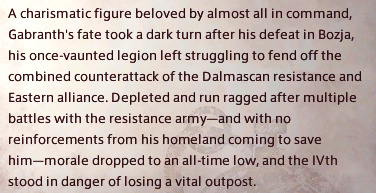
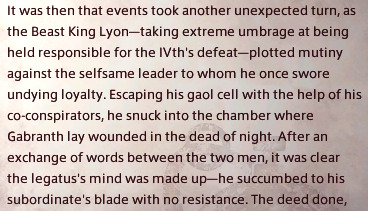
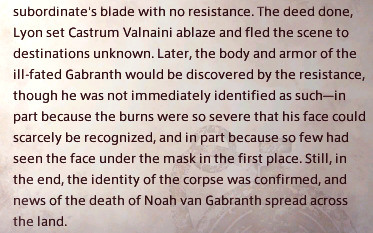
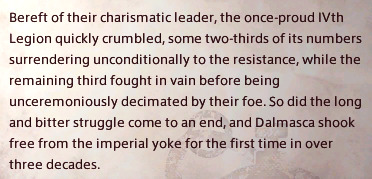
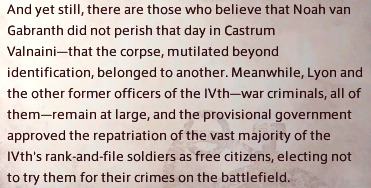

And you might go, “Wow, that’s a wild way to end the Bozja tale” to which I would agree and remind you that none of this is shown in-game, it’s all just in a field note that could be easily skipped over. Yes. That’s right. Dalmasca’s freedom, Gabranth’s fate, Lyon going full mutiny... it’s all in a field note. The ending Bozja cutscenes actually have dialogue like this:


In another scene, with Lyon and Gabranth in Valnain, Dalmasca.



Note: this is an allusion to Noah having the same terminal illness as his father.





The scene ends with Lyon looking surprised at the weapons and Sicinius and Gabranth go to discuss the findings. The scene then cuts to this photo and the questline ends.
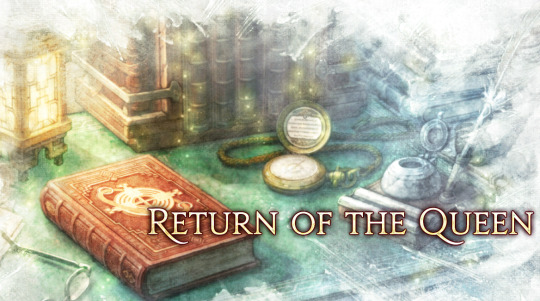
So to put it mildly... I’m mad. Why are we supposed to find out the fate of Dalmasca-- something that’s been in and out of the story since Stormblood-- through a field note? Why is Lyon’s betrayal also found out this way? And Gabranth’s alleged demise? I’m incredibly iffy on the choice to do this in the plot but I would be considerably less mad if any of this was indicated in the cutscenes. I happen to really like Gabranth’s XII’s iteration and the fact that we got a field note on him made me excited. I only found out about Dalmasca being freed, Lyon’s treachery, Gabranth’s death because of that. And that was incredibly jarring to read given the cutscenes I had just watched. There’s no indication that any of that would happen and I can’t help but feel as though that is a bit of lore that is often going to be overlooked by players who simply don’t think to check the field notes for important lore bombs.
I want to reiterate: I'm not specifically mad at the story decision to kill Gabranth (even if it’s a fake death), I’m mad at how this was all revealed to the players. Particularly the bit about Dalmasca. It discards the age-old rule of storytelling-- “show, don’t tell”. I could forgive them for having to cut certain bits of Bozja’s story because of the pandemic severely hampering development but... there had to have been a better way than this. Maybe redo some of the cutscene dialogue? Maybe add in a little bit more to the final scene? I was excited to face off against Gabranth. I was excited to go help liberate Dalmasca, especially after the Return to Ivalice plot really set us up for that in the future. This... just feels incredibly unfulfilling. And I hope that this is not how they decide to end things with this section of the story. The build from Return to Ivalice and the continuation of those plot threads in Bozja were great! Having it unceremoniously ended in a field note? Not so great.
Two honorable mention things that I don’t have the energy to talk about at large
Mikoto’s visions don’t feel significant enough to the story. This is particularly egregious in Zadnor’s arc, where she has a vision where she falls off an airship and then tells the WoL to not say anything because she “doesn’t want people to worry” instead of, idk, trying to find a way to save herself. She only sees herself fall, she doesn’t see herself land. But she insists there’s “nothing we can do about it anyways”. It... felt like they didn’t really matter in the end? Fran ends up deus ex machina-ing a rescue anyways so like... what was the point?
Misija's “redemption through death”, a tired trope that is even more tired in FFXIV. I know there’s two different endings to this quest but Misija being executed after being mortally wounded by the Diablos Armament is the ending I received.
Going to harken back to the criticisms of Werlyt. I’ll maintain my stance that I still think Werlyt had some glaring issues with it... but I will give it this. It didn’t kill off characters from a side plot that had been going on since Stormblood in a field note. And it didn’t involve the Werlytians being like “Hey let’s base our new constitution off of the VIIth legion... that is a great idea.”
Anyways, I still recommend doing Bozja if only because the Dalriada is a good instance with a very good final boss theme. I did enjoy aspects of the questline but the ending really soured my opinion of it.
15 notes
·
View notes
Photo
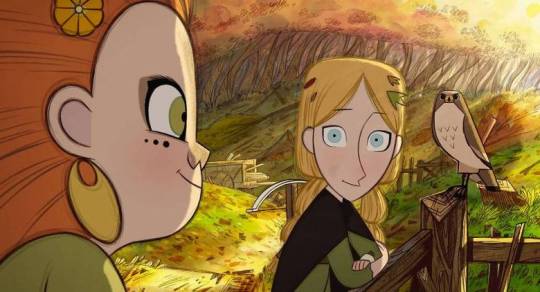
NOTE: This is the first (and perhaps only) film released theatrically during the COVID-19 pandemic that I am reviewing – I saw Wolfwalkers at the Vineland Drive-in at the City of Industry, California. Because moviegoing carries risks at this time, please remember to follow health and safety guidelines as outlined by your local, regional, and national health officials.
Wolfwalkers (2020)
In interviews prior to and after Wolfwalkers’ release, co-director Tomm Moore has described the film as the last panel of Cartoon Saloon’s Irish folklore triptych. That triptych (an informal trilogy) began with The Secret of Kells (2009) and continued with its centerpiece, Song of the Sea (2014). The global environment for animated cinema has transformed since Kells, and now – unexpectedly – Cartoon Saloon finds itself a hub for not just hand-drawn animation, but animation that rejects the crass commercialism emerging from mainstream animation studios (mostly from the United States). With the triptych completed (as well as 2017’s The Breadwinner), one can trace Cartoon Saloon’s evolution from their beginning to its present artistic maturation. While the film asserts its own uniqueness in the Cartoon Saloon filmography, there are connecting strands – aesthetic, spiritual, thematic – of the studio’s previous features apparent throughout. Upon a week’s reflection, I think Wolfwalkers is the studio’s second-best film, just behind Song of the Sea. Even at second-best, this level of artistry has rarely been seen in this young century.
It is 1650 in Kilkenny. Robyn Goodfellowe (Honor Kneafsey) is an apprentice hunter and only daughter of Bill (Sean Bean). Robyn and her father are expatriates from England, and some of their Irish neighbors will not let them forget that. Oliver Cromwell (Simon McBurney) – referred to as “The Lord Protector” throughout the film – has invaded Ireland and looks to secure his conquest over the Irish people (Cromwell is a despised figure in Ireland and lionized by some in England to this day). On an ill-advised trip outside the walls of Kilkenny, Robyn encounters and eventually befriends Mebh Óg MacTíre (Eva Whittaker in her first film role; pronounced “MABE”), a Wolfwalker. As a Wolfwalker, the animalistic Mebh can leave her physical body and take the shape of a wolf while slumbering. Mebh’s mother – who is also a Wolfwalker – has been missing for sometime while Cromwell has ordered the slaughter of all of Ireland’s wolves. Things are complicated when Bill is tasked by the Lord Protector to destroy the wolves living in the woods surrounding Kilkenny.
From the opening moments, lead background artist Ludovic Gavillet (2016’s The Secret Life of Pets, 2018’s The Grinch) sets the contrast between the scenes within and outside Kilkenny’s walls. Kilkenny is suffocatingly geometric, with squares and rectangles dominating the background and foreground. Backbreaking work defines life in Kilkenny, all devoted to the residents’ English conquerors, God, and the Lord Protector. Rarely does the average city resident venture outside the looming outer medieval walls (there are two sets of walls in the city). The structure of Kilkenny is inconceivably box-shaped when seen from a distance. It appears like a linocut. In that distance are the countryside and the forests. As one ventures further from Cromwell’s castle, expressionist swirls define the foliage that seems to enclose the living figures treading through. Green, brown, and black figures twist impossibly in this lush environment. Seemingly half-drawn or faded figures suggest a depthless, dense forest – similar in function to, but nevertheless distinct from, Tyrus Wong’s background art for Bambi (1942). In both Kilkenny and the forest scenes, selective uses of of CGI animation capture the dynamism of certain action scenes – two running scenes in particular employ these techniques (once in joy, the other in terror).
So often in modern CGI-animated films, the animators seem to grasp for heightened realism and minutiae. In such movies, too many details are packed into frames that can only be appreciated if prodigiously rewatched or paused mid-movie. It might feel like completing a visual checklist. In Wolfwalkers, the half-finished details amid breathtaking backgrounds, angular (or round) humans, and simultaneously threatening and delightful wolves almost seem to announce that, yes, humans drew this – and they did so with such artistic flare. In keeping with the references to triptychs in this review, the film itself sometimes divides the frame into thirds (a top, middle, and bottom or a left, center, and right) or halves in moments of dramatic weight. The thirds or halves are separated by dividing lines and are used for various purposes depending on the moment: to save the filmmakers from making two extra cuts, juxtapose differing if not contradicting perspectives, and intensify the emotions portrayed. Less utilized in this film but even more radical than the aforementioned techniques is the film’s use of shifting aspect ratios. Wolfwalkers is principally in 1.85:1 (the common American widescreen cinematic standard, which is slightly wider than the 16:9 widescreen TV standard), but there are notable moments which temporarily dispense of these standards. Like the division of the screen into thirds or halves, the shifts in screen aspect ratio help the audience focus and understand what is occurring on-screen. The most memorable screen aspect ratio shift appears before an eruption of violence.
youtube
The Secret of Kells, too, was set in a city designed in a perfect, orderly shape. That film, like Wolfwalkers, evokes Christianity for narrative purposes. But where Kells celebrated God and found religion as a source of comfort, Wolfwalkers’ depiction of Christianity – specifically, Cromwell’s Anglican zealotry – is without redeeming elements. Under his breath, the Lord Protector prays to God that he will execute any providential commands by any means necessary. In public, he announces his actions as essential to rid Ireland of the lupine paganism that inhabits the wild. Without saying as much, Cromwell’s orders are nevertheless Anglican England imposing its will on Irish Catholics. Irish cinema, until the late 1990s and early 2000s, was usually deferential in its depictions of the clergy and religious practitioners (almost always Catholic). Though it is not unheard of for an Irish film to be critical in portrayals of religious belief, it remains uncommon. And though Cromwell is Anglican and not Catholic (and despite the fact he remains vilified in Ireland), Wolfwalkers’ cynical depiction in how he wields his religiosity as a cudgel is an extraordinary development in Irish cinema.
Tied to the film’s depiction of religiosity are its undercurrents of English colonialism and environmentalism. The latter will be obvious to viewers, but the former might cause confusion during a first viewing because it seems to be, at once, on the periphery and yet central to Wolfwalkers. Cromwell being referred to as “the Lord Protector” for the film’s entirety is indicative of screenwriter Will Collins’ (Song of the Sea) decision not to provide much historical context within the film. English colonial oppression usually occurs off-screen or is implied. This seems inconsistent with Cartoon Saloon’s work on The Breadwinner. That film identifies and openly describes Taliban injustices.
So what gives? As much as those who admire animated film disdain perceptions that it is solely for children (like myself), animated film is oftentimes a gateway for children to be exposed, eventually, to other corners of cinema. Can children understand Anglican-Catholic tensions in Cromwellian Ireland? Perhaps (especially British and Irish children), if presented with enough care. But the answer probably lies with the fact that the thematic goals of Wolfwalkers are more aligned with Kells and Song of the Sea than The Breadwinner. Cartoon Saloon’s Irish folklore triptych is concerned with how the Irish are inextricably, spiritually, bonded to the environment. There is a balance between humanity and nature – a mystical connection that, when disrupted, brings harm to all. The Breadwinner, though very much a part of Cartoon Saloon’s filmography, is grounded in recent history and, because of recent developments in the Taliban’s favor concerning the Afghan peace process, present-day concerns. In the film, fantastical stories are used to bring Parvana’s family together as the Taliban tighten their grip before the American invasion. This has little bearing on the folklore-centric storytelling of Wolfwalkers, but Collins, Moore, and Stewart’s editorial decision to downplay the film’s historical basis tempers any messaging they wished to convey.
Wolfwalkers meets The Breadwinner in its depiction of a young girl growing up in a male-dominated society. This film’s lead was supposed to be a young boy. But the story, to Collins, Moore, and Stewart, just did not click with the original male protagonist. As such, the trio made the decision early in the film’s production to switch the protagonist’s gender. Robyn, an English transplant to Ireland, is allowed remarkable freedom to do whatever she wants with her time in the opening stages of the film. This arrangement cannot persist as her father falls from the Lord Protector’s good graces. She is relegated to washing dishes from daybreak to dusk in the scullery – a task that she, in her heart, rejects for its gendered connotations. Robyn wears a Puritan’s frock while at the scullery, a uniform she has no desire for. While outdoors beyond the Kilkenny walls, she wears what her father wears – pants! – while out hunting wolves. Other than her father, few in the city care for Robyn’s intelligence and instincts. Most everybody ignores her protestations and truth-telling about the things she has seen in the forest. By film’s end, she is vindicated, in spite of Cromwell’s (and, to a lesser extent, her father’s) bluster and bravado.
This film also contains potentially queer subtext between Robyn and Mebh. Writers more skilled than I will provide better analysis of that subtext. Nothing explicit is shown, as the two are still children. Yet the nature of their friendship, the themes contained in Wolfwalkers, and some unspoken moments between Robyn and Mebh seem to relate a possible queerness. The film also does nothing to present either girl as heterosexual. Queer or not, Wolfwalkers shows the viewer a blossoming friendship between two girls – not without its tribulations, but rooted in their common earnestness.
Unlike previous films in Cartoon Saloon’s Irish folklore triptych, there are no notable original songs in Wolfwalkers. French composer Bruno Coulais and Irish folk music group Kíla are Cartoon Saloon regulars and return for Wolfwalkers. The musical ideas for Wolfwalkers’ score are not as apparent as the previous films in the triptych, as they are not quoting a song composed for the film. But the use of Irish instruments in their collaboration lends at atmospheric authenticity that only heaps upon the film’s sterling animation. Norwegian pop sensation AURORA has altered the lyrics and orchestration to her 2015 single “Running with the Wolves” to accompany a running scene that, by the filmmakers’ admission, was inspired by the running scene from The Tale of the Princess Kaguya (2013, Japan). The scene pales in comparison to the context and music from the late Isao Takahata’s final film, but Wolfwalkers is a movie more than the sum of its parts.
Production on Wolfwalkers was in its final stages as the COVID-19 pandemic reached the Republic of Ireland. When the Taoiseach, Leo Varadkar, announced a countrywide lockdown on March 12, 2020, Cartoon Saloon had already started preparing for a lockdown contingency three weeks’ prior. Clean-up was divided between Luxembourg-based Mélusine Productions and Cartoon Saloon’s headquarters in Kilkenny. After assessing the needs of the clean-up animators, both studios moved to remote work where the most pressing complication was their Internet bandwidth slowing down upload speeds.
Cartoon Saloon’s Irish folklore triptych is finished. In the last eleven years, the studio has proven itself one of the most interesting and important animation studios currently working. They have even proven they can make quality films without its primary director, as evidenced by Nora Twomey’s The Breadwinner (Twomey’s next project for Cartoon Saloon is My Father’s Dragon, slated for a 2021 release). Though just an indie studio with limited resources, their standing in animated cinema has only strengthened with this, their most ambitious film to date. It might seem like a rehash of the animation from Kells, but Wolfwalkers has improved upon its predecessor, and boasts perhaps the most beautiful artwork of any animated movie released this year. The film’s grandeur belongs on a movie screen, but, understandably, very few will have the opportunity to experience it in such an environment. This latest, ageless triumph will outlast these extraordinary times.
My rating: 8.5/10
^ Based on my personal imdb rating. Half-points are always rounded down. My interpretation of that ratings system can be found in the “Ratings system” page on my blog (as of July 1, 2020, tumblr is not permitting certain posts with links to appear on tag pages, so I cannot provide the URL).
For more of my reviews tagged “My Movie Odyssey”, check out the tag of the same name on my blog.
#Wolfwalkers#Tomm Moore#Ross Stewart#Cartoon Saloon#Honor Kneafsey#Eva Whittaker#Sean Bean#Simon McBurney#Maria Doyle Kennedy#Will Collins#Bruno Coulais#Kíla#Paul Young#Nora Twomey#Ludovic Gavillet#My Movie Odyssey
49 notes
·
View notes
Text
The Walking Dead, “Days Gone Bye” | Analysis
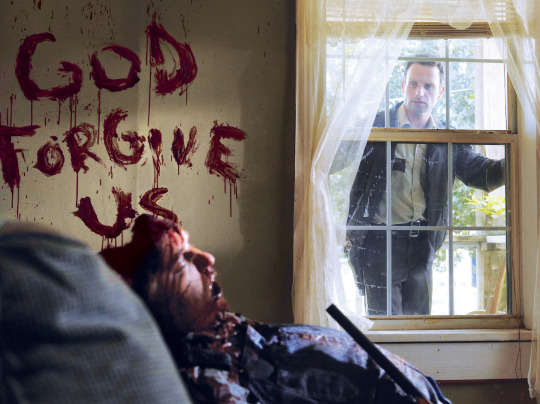
The final season of The Walking Dead comes in August, so I decided to rewatch the show from the beginning as the end is nigh. TWD has been a part of me since I started to watch TV series, and I’ve watched Days Gone Bye more than seven times, so this is certainly one of the pieces of audiovisual media that I’ve consumed the most. To add a new interesting layer in my rewatches, I’ve decided to see the episodes with a critical and analytical lens, seeing it more than just as a pastime, and write my thoughts here. This will be a great ride for me, and I can’t wait to see again some iconic moments from TWD throughout the seasons and write about them.
Part 1: The World Before
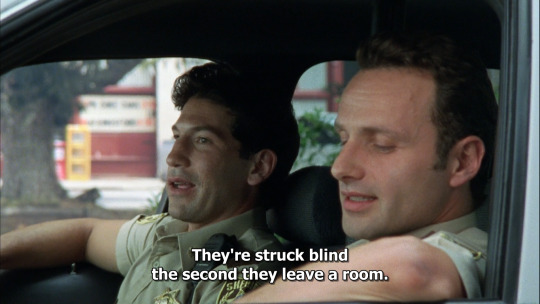
Before getting into the first act of the episode, let me talk about the teaser – the first five minutes of the episode – quickly. As this is our introduction to the world of TWD, Days Gone Bye couldn’t simply start with Rick and Shane having a chat. So it was necessary that the teaser served as a way to establish both the tone and setting of this story, and it certainly does. The teaser tells us that what we are watching is a gritty survival horror story that takes place in a post-apocalyptic world, and the teaser establishes this perfectly without no more than two lines of dialogue. It is established visually: Rick stops his car on a deserted road with no traces of civilization anywhere, then goes to an abandoned gas station where other cars are – and those cars have dead bodies inside. From there, we know right from the start that this isn’t the world we live in. When Rick sees the young girl that is in fact a walker, it is established that this is a world where the main threat are zombies. At least for some part, as in future episodes the series will show us something far more scarier than walking cannibal dead bodies is the real danger.
Now storytelling-wise, TWD already proved its value in the first five minutes. Frank Darabont directed the episode and wrote the script, and his work in the episode both as director and writter is fantastic and set the bar high if the series wanted to have a consistency of greatness in its episodes. After the perfect five minutes purely composed of visual storytelling, the first scene of the first act is dialogue-heavy and character-driven. One would think that it is to establish to us that Rick and Shane are friends, that Rick has a wife and son and that they are cop buddies, and one would be right, but it is also more than simply introduction and exposition, and that’s the beauty of the audiovisual medium as a whole.
Reading books about screenplay writing, I’ve come to know more about subtext and its applications in both movies and series. Despite this first scene doing great work in introducing us to the two main characters of the season – their mindset, persona and some backstory – it also adds so much worldbuilding-wise. Shane goes on his rant about women not switching off the lights in a house before leaving it, and Rick talks about a discussion he and Lori had earlier. See, the teaser showed us a decaying world with walking bodies. Now, the first minutes of act one show us a world where people worry about such trivialities: switching off the lights. In the tagline for the first volume of the comic book, it reads “The world we knew is gone. The world of commerce and frivolous necessity has been replaced by a world of survival and responsibility“. The scene I mentioned is basically the live-action adaptation of it. We see the world of commerce and frivolous necessity in this introduction so we can understand better and fear the world of survival and responsibility that will come later in the episode. TWD started geniously: it went from visually-driven to dialogue-driven, and after that to visually-driven storytelling, all without losing its verisimilitude and charm.
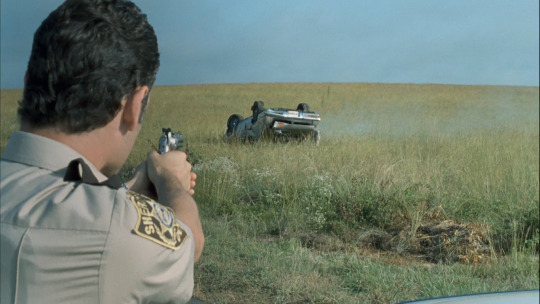
Now, something about the visuals I loved: the grainy aspect. Because this episode was shot on film – in fact, up until season ten all episodes were shot on film – the film grain is obviously visible. But instead of being just an aesthetic choice – shooting in film or digital – I think it’s also meant to have implications tone-wise. The comic books this series adapt is in black-and-white (something unusual in American comics), but it’s because the writer Robert Kirkman wanted the comic to feel like a classic George Romero zombie flick, and it worked completely. Commercially, a black-and-white TV series wouldn’t be much embraced by a large and mainstream public, but I think that Darabont solved that problem and succeeded in maintaining an aesthetic similar to the feel the comic book wanted to transmit. The excessive film grain – something that made me feel like watching a Panos Cosmatos’ movie but without the acid trips – works because it resembles the Romero zombie flicks in color, like Dawn of the Dead. It is a classical and archetypal zombie story – even if it subverts some conventions various times throughout the series – and the visuals tell us that.
Not only that, but the episode has many moments that resembled The Mist in some ways: the camera being close to its characters to make the story feel grounded and experienced by real people, the back shots to make the audience feel like they are following the characters in their journeys, the handhold camera moments that gives a documentary feel, adding a realistic perspective. All that grants a grounded vibe to the episode, which works because this is a story about how people react and live in a lawless world which can kill them at any possible moment without any warnings. It’s where chaos and anarchy reigns and where death always lurks. A story like that works better when it’s experienced through the eyes of the characters. It’s also best represented in the moment where Rick leaves the hospital and sees the sun for the first time. In the shot, the Sun is blinding us with its shining light, but then there’s a cut, and in the next shot we see only Rick covering his eyes while the blinding sun rays don’t make it to the camera. It’s the switch of subjective to objective perspective, as in the first we see the world with Rick eyes – it’s a man getting out of the dark for the first time in months – and in the second we see the same moment but from outside lens, and it showed us that this a day like any other where the sun doesn’t blind you. Besides, this episode has a low budget sensitivity – not meaning that the quality is subpar, but that it has an authenticity that is extremely convincing. It is that low budget quality that makes the story feel real in a certain way. That is, of course, until the tank in the middle of a city is shown, but even with the realism, it is still tangible, and the story continues to feel realistic in its depiction of a zombie apocalypse in the “real world”.
Not only that, but the episode has many moments that resembled The Mist in some ways: the camera being close to its characters to make the story feel grounded and experienced by real people, the back shots to make the audience feel like they are following the characters in their journeys, the handhold camera moments that gives a documentary feel, adding a realistic perspective. All that grants a grounded vibe to the episode, which works because this is a story about how people react and live in a lawless world which can kill them at any possible moment without any warnings. It’s where chaos and anarchy reigns and where death always lurks. A story like that works better when it’s experienced through the eyes of the characters. It’s also best represented in the moment where Rick leaves the hospital and sees the sun for the first time. In the shot, the Sun is blinding us with its shining light, but then there’s a cut, and in the next shot we see only Rick covering his eyes while the blinding sun rays don’t make it to the camera. It’s the switch of subjective to objective perspective, as in the first we see the world with Rick eyes – it’s a man getting out of the dark for the first time in months – and in the second we see the same moment but from outside lens, and it showed us that this a day like any other where the sun doesn’t blind you. Besides, this episode has a low budget sensitivity – not meaning that the quality is subpar, but that it has an authenticity that is extremely convincing. It is that low budget quality that makes the story feel real in a certain way. That is, of course, until the tank in the middle of a city is shown, but even with the realism, it is still tangible, and the story continues to feel realistic in its depiction of a zombie apocalypse in the “real world”.
The whole sequence of the car chase and the shooting between the cops and the criminals is beautifully conducted by Darabont, who knows his craft remarkably and executes it in a manner like no one else does. The memorable shots, shot by Darabont, immortalize the whole sequence and reach its climax – the gunshot Rick suffers – perfectly in a crescendo that works better here than in the comics, this being an easy task, but still, Darabont managed to do it in an impressive way, totally deserving a bravado status.
Also, something that I also appreciated, and I think it’s overlooked: when the police cruiser where Rick and Shane are passes through a road, we see a single crow eating a roadkill. What do this mean exactly? Animals can’t turn to zombies so one might think this is only a moment with no meaning behind it. But now I interprete it as a symbol. It is meant to represent that society has be decaying long before the dead came to eat the living. It remembers me the first Mad Max, where the world is not in the same level as it appears in Mad Max 2: Road Warrior – a full-on post-apocalyptic society – but it is in its final stages, leaning to barbarism and uncontrollable chaos. The producers of TWD announced an anthology spin-off series named Tales of the Walking Dead, and it certainly would be interesting to see more of the transition between our world and the post-apocalyptic zombie-ridden world, showing the process in-between of transformation and decay.
Part 2: Brave New World
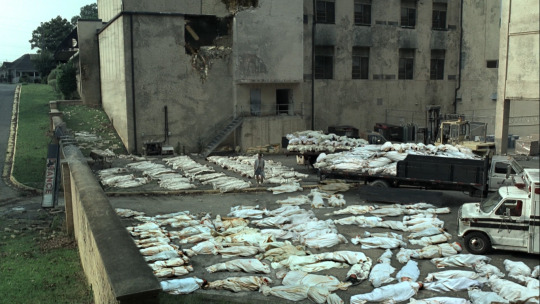
The second act starts as Rick steps out of the hospital and faces the current reality of his world, and it’s an ugly one. Rick sees dead bodies everywhere and discarded military gear. Something dreadful happened when he was in a coma. The world undergone a change so great in his sleep that it’s impressive that Rick didn’t drown in total madness when he first saw what’s left of society. Most of act two is about Rick having to come to terms with his new life: one entirely ruled by survival. Now, another interesting element that is also a symbol in my interpretation: the bicycle girl. The bicycle girl (which is the zombie without its lower body) is the first walker Rick encounters. He is scared by her and runs away from her with the bicycle that was there next to him. The bicycle girl is nothing more than the remains of the past life of Rick and the world before. It is dead and alive at the same time – like the walkers – but in a pitiful state. It can’t be on its feet and is always trying to grasp and touch Rick, but, ultimately, it can’t. Rick fears it, and because of that he runs.
Most of the second act is focused on the interactions of Rick and Morgan Jones. Morgan, after encountering Rick and saving him from a nearby walker, takes him inside his house, but fearing that the gunshot wound was in fact a walker bite, Morgan rightly tied Rick to a bed and waited for him to wake up to ask some questions. Now, it’s incredible how this episode never misses a beat and is not made of only three truly great scenes, but all of the scenes are great. The whole dinamic of Morgan explaining to Rick what happened and what it takes to live in this new world felt so natural that no critic could say it was bad exposition. It was exposition done right, revealing more about Morgan’s character, showing him as a good man and a father to his son Duane. It’s easy to understand why Rick and Morgan liked each other one day after meeting for the first time. The chemistry is real, and it’s unbelievable how seasons later, when they see each other again, the chemistry is still there.
Andrew Lincoln and Lennie James are spectacular actors. Their acting in this episode is astonishingly extraordinary. I’m pissed that they didn’t won any awards for it, they certainly deserve it. Andrew’s acting was great all way through, but when he first arrives at his house and cries for Lori and Carl you could feel the man’s pain and suffering. One moment that is perfect and maybe one of the bests of all TV history is when Rick is having an existential crisis. “Is this real? Am I here?”, asks Rick while facing the ground. It’s such a powerful reaction to the absurdity he is experiencing and it feels so damn real because Andrew Lincoln can cry like a pro and give the gaze of a man that is lost. Rick is lost. And this scene can provide such a powerful punch to the audience that you can’t help but be already invested in Rick’s journey. He just wants his family, so he can put some sense in a mad world. Without them, Rick is lost.

The second act makes us empathize more with Rick and Morgan. They both have admirable goals. They just want to live and provide for their family. Their bond is developed exceptionally in their final moments together – before Rick travels to Atlanta – that you are left caring for them and wanting a reunion. The final scenes of act two were made to make you feel emotional without doubt, and I’m sure that it worked on some people and made them fall in love with the series instantly. It’s when Rick kills bicycle girl and Morgan fails to kill his dead wife, now a walker. The soundtrack by Bear McCreary is phenomenal and adds so much dramatic and emotional weight to the scenes, and it fits perfectly with the tone of pretty much the core of the series. It’s a haunting song, a sorrowful one full of melancholy, but it also has a spark of hope in it. It makes a statement: everything is sadly collapsing around us, but there’s still hope of rebuilding. The Mercy of the Living is TWD summarized in an orchestral piece, and I feel like crying every time I listen to it, just like the piece Alive Inside of Telltale’s game, that also does a masterful job in creating a sad but hopeful atmosphere in its melody. The bicycle girl – which is the past Rick and the world before – must be killed by Rick if he wants to continue his voyage, to which destination is his family. Rick is teary and heartbroken in killing bicycle girl because now he has to fully embrace a life ruled by survival. “I’m sorry this happened to you.” is Rick final message and requiem to the world and consequently to his past self – a quiet Rick that didn’t want to discuss with Lori in front of Carl –, both who had problems that they couldn’t resolve before the tragedy that hit them.
Part 3: The Beginning

The third and last act are in fact the beginning. We saw a peak of a world before the zombie apocalypse and Rick waking up in this desolated society in the first two acts, but the third one is to introduce and set up what the series is about and what will do to its end: show the characters in a battle for survival, and ultimately in a quest for the return of humanity and civilization. Both are depicted in the scenes where Rick is trying to save himself from a horde of walkers that attack him and his horse, and the other with Shane’s group listening and trying to talk in the radio with a mysterious survivor (Rick himself) who warns about his coming into the city, showing their efforts to help fellow survivors who might enter Atlanta without knowing its dangers, thus demonstrating that they are still human after all.
The episode show us a little about the relationship of Shane and Lori, as well as a glimpse to their group. It wasn’t exactly necessary, but it doesn’t hurt in any way the season’s progress and development. The third act is best represented by Rick entering Atlanta and having to escape a humongous horde of walkers. Rick manages to survive by hiding in the tank that was parked in a street. The scene also show us that zombies had some intelligence – they crawl and try to open things – and some of them look cartoonishly green or grey, instead of the realistic putrid rotting flesh look the marvelous make-up by Greg Nicotero can provide. And both of these things are common to the iconography Romero made for the zombies. It’s very clear that Darabont takes inspirations from his movies and respect their legacy by expanding it to a new range of people and an audience that is maybe not that familiar with Romero – I wasn’t when I first watched TWD and when I saw Romero’s movies I was impressed by how it influenced the series.
Days Gone Bye is a masterclass of how a pilot should be made. This quintessential pilot introduces a storyline that will be finished within the episode. while also setting up what’s coming next in the season, laying ground for all the future episodes in the best way possible. It introduces a protagonist that proves that he can sustain a show on his own – he is a caring father, loving husband, a good man and a kind of Western hero, we see him riding in his horse towards the imminent danger full of guns and determination searching only for his family. The Walking Dead may not be recognized as a TV series that revolutionized the medium, but it revolutionized its genre, and overall it is a great series that deserves recognition, and so does Days Gone Bye. It is simply the perfect pilot.
12 notes
·
View notes
Text
A while back, I made a post about how there are at least three different interpretations of Frozen 2′s ending and how they can ALL be justified by the text of the film to some degree. I’m bringing that up again because I saw a post with people who have different opinions on the ending discussing the matter, one who considers the ending a separation and dislikes it and one who considers that there is no separation.
The thing is... I think both sides are right, if that makes any sense at all? Because they’re both looking at different aspects of the text. In the same way, I think that the people who consider the ending a separation” and feel that separation is a good thing are also pulling from aspects that are in the text.
Everyone’s interpretation is rooted in the text to some degree, but also colored by their own feelings and the way they approach the text.
Now, I realize when I made my post about there being different interpretations of the ending, I was trying to be as neutral as I possibly could be and I didn’t bring up my full opinion on the matter. That was because I was striving for neutrality in that post, but since I’m bringing this up again, I might as well share my opinion so that others understand what my take is and don’t start speculating that I’m trying to play all sides or something.
As I said in my first post, I feel that “the sisters did this together and are still bound by love even if they are moving forward on individual paths” is closest to what the film wanted to say. I believe the filmmakers wanted to establish that there is no separation and that the sisters compliment each other and can still work and enjoy life together why being on individual paths. I feel that this was the film’s intent and I value and appreciate that intent.
But here’s the thing. I also feel that isn’t what the filmmakers actually wrote. I know that was what the filmmakers were trying to build towards, but I feel there are loose ends in F2′s narrative that make those other interpretations possible. And I’m NOT saying that to bash Frozen 2. I recognize that crafting a film is a difficult process where you have to keep countless pieces and plot threads in mind, as well as keeping your target audience in mind and the studio heads above you in mind. And I have great respect for the filmmakers and the effort they put into creating this piece of art. The fact there are going to be loose ends is inevitable and I don’t want to sleight the filmmakers and their craftsmanship. But for me personally - I can’t simply judge a film based on its intent when some of the loose ends bother me.
When some fans (either fans who criticize the film for dividing the sisters and don’t like “separation” or who celebrate the film for dividing the sisters and do like “separation”) point out that “Elsa and Anna didn’t really do this together - acting in common cause, yes, but not working together or approaching the situation from the same wavelength and talking things out together,” I kind of feel that.
When some fans talk about how Anna didn’t get the chance to air her anger at Elsa, I also feel that. Keep in mind, I’m not anti-Elsa or “Elsa-critical.” I love Elsa as a character dearly. But I find it clumsy on a storytelling level to introduce a conflict between the sisters (and a moment where even Olaf becomes angry, highlighting its seriousness) and then not resolve that conflict. I know, I’ve read people’s explanations saying that Anna is too overwhelmed by emotions to feel anger and that the sisters can talk things out at a later date easily enough because the torn fabric is already mending with their reunion (and I agree with that, actually)... but that doesn’t change the fact that a plot thread is left kind of up in the air, to be resolved at a later date. Saying that something makes sense in-universe does not address the structure of the film.
So I sympathize with people who have issues with the ending. I’ve seen Anna fans say she got the fuzzy end of the lollipop by not being able to express her anger, regardless of how much sense people might argue it would make sense in the moment. And their feelings are valid because the film introduces a plot thread and then doesn’t tie it together by the end - or, if we feel it tries to tie it together by having Elsa say, “You saved me,” and validate Anna, does it in an abrupt and rather rushed way. The film would have worked much better, I feel, if they included the deleted scene of Elsa showing Anna their parents, which would have been a clearer gesture of healing and also given Anna some much needed emotional closure. (At the same time, I personally disagree with certain folks who have an overly negative take on Elsa or try to paint her as a “bad sister” across the franchise. Making such an argument doesn’t hold water when you look at all the different films and shorts of the franchise.) And I’ve seen Elsa fans express frustration because they see Elsa’s behavior as unearned. And, while I wholeheartedly reject individuals who degrade the Northuldra or go outside the text of the franchise to make their points, I feel it is valid for some people to feel that the conclusion comes across as somewhat unearned. By that point in the film, we are racing towards the credits because the filmmakers only have an animated film’s runtime to work with. So things don’t get the proper time to breathe. And while again, I recognize that is all part of working within the constraints of an animated film and laud the filmmakers for doing the best they could in their circumstances, I also feel that abruptness ended up being detrimental to the finished project.
In my personal opinion, the sisters still have a lot they need to talk through together and process - and that’s what rubs me the wrong way about the ending. The film frames its ending as a resolution to the conflicts it introduces. And on one level, it works - Elsa and Anna are both able to come into their own in some distinct and beautiful ways. But on other emotional levels, certain things are left hanging. We don’t get to see the sisters process together the conflicts that have arisen between them. You could argue that their stepping into their own gives them personal senses of closure... but that’s not the same as being able to talk out and address together the emotional conflicts that F2 introduces to further its plot. And even though you’re right if you argue, “But in their new positions, Elsa and Anna both have the time and opportunity to address those issues together!”, that’s not the same as the film addressing the issues that it sets up. That rests resolution on a hypothetical Frozen 3 which as of this writing doesn’t exist.
Although the film’s ending frames itself as a resolution to the conflicts it introduces, it does not resolve all of those conflicts, particularly the emotional ones between the sisters. And even if we consider the ending of the film as a new beginning, the film doesn’t really do much to foreshadow the future resolution of those conflicts.
So F2′s ending leaves me kind of cold. I don’t dislike the ending on principle the way some people do. I KNOW what the filmmakers were going for. (I even really like what the filmmakers were going for. That’s why I love delving into the new status quo in fanfiction.) I just don’t think they fully achieved that.
And so I feel the film’s conclusion isn’t earned - or at least, isn’t as well-earned as it could have been. Again, I respect the filmmakers for what they were trying to do. I just don’t think they succeeded.
And I feel that people are within their rights to critique the film’s flaws - as long as they are not being hostile to others about it. And, of course, people are within their rights to love the film and celebrate the things it does beautifully.
I hope I manage to do both, critique and celebrate.
31 notes
·
View notes
Text
I forgot to watch content all week so i wrote about games ive been playing
9/2/2021: The Truman Show
You should fear your fears but embrace them and use them to guide you into the unknown, to explore and experience what life has to offer. Fear stands between you and the fullest experience of life so you must pass through it to better yourself. Heed not the walls built about you and the chains made to hold you. Though the architects insist it will preserve your life, containment is anathema to life. Do not take in faith the benevolence of powers that be; instead trust those who would support and liberate you, guide you through fear and into life.
As best I can lay it out, I think this is the philosophy of the Truman show but there is so much more to read into it also. There is critique of systems of commodification and celebrity (i.e. capitalism) reducing human beings to a consumable good as well as encouragement to find and pursue your goals despite adversity and even sensibility which is also tied to the illusion of economic responsibility. You can’t put a camera inside a human head, you can never “know” them without being an active and intrinsic part of their life, but also there is need for reciprocation. If one half exists with ulterior motive then the entire relationship is rotten; sincere humanity is what creates real connections. Without such your world is fake. A world built around one person is a world where no one can truly live. All these actors have given up basically their entire lives for the sake of watching Truman have his life built around him by outside forces, have allowed themselves to be commodified and dehumanised for the good of one man, Christoph. The man at the top has delusions of grandeur and thinks only of his own bottom line, he cares not for his subjects but simply wants them to do as he tells them because it benefits him to commodify their lives and interactions. Even then he cannot stand to lose control and in seeking to demonstrate Truman’s “realness” he structures his life so thoroughly that eventually there’s no reality left, only a script and adverts. But the people watching still empathise with Truman because everyone in the working class understands what it is to be trapped because real life is our own Truman show and one day we must all pass through fear, step out of the dome and create a real life for ourselves outside of the system of commodification which consumes everyone’s life and removes all realness and sincerity and emotional catharsis from it.
I unreservedly love this film.
14/2/2021: Assorted Game Reviews
Horizon Zero Dawn (Unfinished due to technical issues, 45 hours inc. parts of Frozen Wilds): This game is really cool and really fun. I think it is defined by its incredible setting which somehow creates a fresh feeling post-apocalyptic environment. Said environment creates intriguing alt-future lore and some very interesting environments to explore. I love the machine designs (especially tallnecks!) and was very sad to hear one of their contributing artists passed away recently but I’m glad their work lives on in this visually stunning game. I’m a sucker for Ubisoft-style open world games simply because it tickles a certain kind of itch and somehow this non-Ubisoft game has outdone Ubisoft on their own formula, which is hilarious, but also good for me as running around this world exploring and clearing map markers is engaging fun. Not least because of the combat. I have a minor criticism here that the combat feels slightly awkward on mouse and keyboard, the arrows never seem to go where I’m aiming, but aside from that the experience of fighting is a grand one. Enemies never lose their threat and I love the weak spot system the game employs which makes every tool useful in niche circumstance and rewards curiosity. It specifically manages this in a way that I feel the Witcher series could learn from if it ever returns; by making head on assault less viable and encouraging tactical hunting. I do feel this system makes hunting robots so fun that by contrast hunting humans becomes a chore however, though I noted this improves in the dlc with the addition of humans with elemental weaknesses limited in number as they are. I cannot speak for the story in entirety but what I encountered was pretty good, though I feel as if it was only just really getting going at the point where I could not continue. I find Aloy to be a compelling and well portrayed protagonist and though I can guess about her origin and the ultimate end of the alt-future apocalypse I still want to see how it plays out on screen, so will return to this as soon as I’ve fixed it.
Rimworld (122 hours. Familiar with but do not own Royalty Expansion):
Rimworld is one of those super special games that I don’t think I have a single problem with. Fair warning it can be brutal and is heavily dependent on RNG but this allows it to create truly unique and interesting scenarios on a constant basis. In the wider perspective it could be described as formulaic, with regular cycles of managing the settlement between raids and random events, but the devils in the details. Colonist traits, health and skills dictate how you play and sometimes you’ll be forced to adapt as some colonists simply refuse to perform some tasks. The depth of health particularly amuses me, in that each little part of someone’s body is modelled in a way. If you’re in a firefight you may take a single bullet which grazes your finger and you’re fine. Alternately it could pierce your human leather cowboy hat, your skull and kill you instantly and the game will tell you exactly what happened. The risk/reward element is addictive enough, and that’s without accounting for just how cool it is to see your colony slowly expand. Establishing more and more options for crafting is fun and shows off the full range of different items in the game which is fucking extensive. Between clothing, weapons, armour, sculpture and drugs to name only a few you have the opportunity to create many varied production lines either for your colonists or to trade for money and there is a lot of fun to be had here as well as it is quite satisfying to see psychoid you have grown personally become the cocaine your colonists snort to help them stay awake on limited sleep. From an archaeologist’s perspective it is especially cool to look back over your base and see the hints of how and why structures were built and remember the history of your limitations and development through structure. I think the lore of the universe is really cool too, a very 40k-esque kind of place except with far less order, somehow. But the universe does an excellent job of feeling alive and moving constantly on both a planetary and interstellar level. You can fully believe that while you build wooden shacks to shield yourself from terrifyingly low temperatures there are simultaneously rich pieces of shit living it up on the glitterworld that’s one system over. The music does an excellent job of creating the wild west frontier atmosphere the game cultivates to great effect. Ultimately, for just being a grid with a series of different numbers attached, this game does a fantastic job of creating a compelling, brutal and very real colony management experience. I dont think I can properly put into words the grandness and scope of this one. I didnt even mention the modding scene, which is expansive and tailors to basically any need you could have. The Rim is a terrifying place but theres so much fun to be had.
Factorio (86 hours, mostly 1.1): Having completed a game of Factorio I can tell you reliably that this is one of the best games ever made, thoroughly addictive and fun. If you like numbers, logistics, TRAINS, its gonna be your thing. Not to mention its probably the only documented case of a game with no bugs (so far as official forums are concerned). Strictly speaking this games combat is not the most engrossing thing but good lord do you feel it when you acquire a flamethrower. The way each aspect of the game (production, research, logistics, combat, upgrades for everything therein) feeds into the next is a really well constructed balancing act such that you must experience the full game in order to complete it and I always appreciate this kind of design. I think its one of the best tenets of factory game design especially as its something present in Satisfactory too. Beyond all of this generalised good the game is also excellent in its intricacies, the architecture necessary to build a maximum efficiency base, the level of planning and organisation that can be employed is mind-blowing. Not to mention the mod community, factorion is already an extensive experience and some mad bastards have seen fit to complicate it further, hats off to them. This really is a great moment in gaming.
Destiny 2 (198 hours, all expansions, played some post Forsaken release, mostly Season of Arrivals onwards, spent roughly £20 on microtransactions):
This is a very interesting and enjoyable experience, but I must say it can be a bit controversial at times. What its does particularly well is moment to moment gameplay and design in all aspects. The game is stunning; between environments, cosmetics, shaders ships and ghosts there’s a vast range of incredible things to see, all rooted in the “pseudo-magi-science” aesthetic it’s got going on. The class design is excellent and you really do feel like you embody this rampaging madman / agile gunman / space wizard archetype, whichever you choose to play. The abilities, especially supers, are very satisfying. Everything has heft and power behind it which can be felt in all aspects of design; sound and animation is top notch. Movement is cool, you can feel how fast you move both on foot and in vehicles and the navigation has a little fun subtlety depending on your class jump, even if you can bounce unpredictably occasionally. But for the love of god why is the wall kick in there? It has only ever served to push me from a ledge into a bottomless pit. You're looking to remove antiquated content? Start there. Some guns are not so good to shoot but there’s such a great range of guns that are fun its like complaining about one drop in an ocean; and enemies are fun to shoot at, each faction distinct in meaningful ways and presenting an effective challenge. Speaking of oceans, that’s one way to describe the lore. I haven’t dived too deep but it keeps going down forever and everything I’ve read is intriguing. As a former Elder Scrolls lore nut this is something I could definitely sink my teeth into, though its much more of a pulpy sci-fi vibe than a pure nonsense vibe. I do think the game has a bit of a loot problem, primarily in regards to the conflict between high stats and looking good. This should never be a conflict, and yes you can apply ornaments to any purple gear but that’s not enough when I spend the entire time grinding power levels and thus must change armour and weapons on a constant basis to progress. This game needs a true transmog system and if not that, rethink how gear power level works. Perhaps rather than earning new instances of gear you always possess a version of it and the loot you acquire in missions just upgrades your instance to your current overall power level? This would serve to do away with the current upgrade system which I think is a needless additional grind. Perhaps it could be retained in using enhancement cores to empower gear as present but necessitating a whole upgrade module to keep your favourite weapon on hand is kind of painful honestly. There is also at present the issue of sunsetting gear, mildly controversial to say the least. If it’s necessary to streamline the game and make it function moving forward so be it but surely loot pools should be adjusted so you can actually get useful loot from older locations? And why sunset personal instances of gear which can be acquired at the regular power level anyway? I had to throw away my favourite bow and hunt down a new version of the exact same weapon for… what reason? I do think destination navigation leaves a little to be desired also. I get that having a physical hub world is meaningful but Destiny does not have a very extroverted community; I can count the times someone noticed me in the tower on one hand. And its not even like there’s fun activities to be found in the same sense as say Deep Rock Galactic, which really does take advantage of its hub. Perhaps for players who simply want to go about their business all of the vendors could be set into a menu system where just clicking an icon takes you to their menu from anywhere in the system rather than, per se, having to go through an entire loading screen (Which takes you to orbit and back) to reach a location which serves simply as the front for four menus. These are established player problems. As a dedicated PvE player I can say that this game is immensely fun in combat and growing in power does feel really good. It’s something I recommend getting into, there’s just some very large creases that need ironing which the Bungie should really take the time to address rather than pushing out new in game content every three months.
#the truman show#horizon zero dawn#rimworld#factorio#destiny 2#d2#film#movies#video games#i dont know what im doing#hzd#opinion
17 notes
·
View notes
Text
So I’m kinda in a meh/apathetic headspace in regards to my mental health right now. Maybe it would be best to just let some thoughts out.
Firstly, I do want to apologize for making stupid, borderline inflammatory posts and throwing them out there onto tumblr dot com, I know that’s never the best course of action. However, I really, really do not appreciate anons sending vague “are you okay”s at me. If you’re not close enough to me where you can’t PM me (relatively) face-to-face, then I really wouldn’t like random inquiries about my mental health from you. Maybe it’s just because I don’t 100% trust anons (I’ve been here for a decade, I’ve seen some shit, can you really blame me?) but I think I ought to make myself clear on that. Are we clear on that? cool.
I don’t know... I’ve felt so lost and tired recently, moreso than usual.
I’ve always had a massive complex about annoying people, being too self-indulgent, not having good ideas or opinions or what-have-you. People who have known me for a while almost definitely know that. I don’t think it all necessarily exists in a vacuum, either I have a genuinely hard time coming up with objectively good ideas. Sometimes I’m just straight-up “head empty” mode. I’m also often really opinionated and sometimes intend to die on hills that people aren’t really meant to die on (or are even necessarily worth dying on). I can get way too wrapped up on meaningless things because my brain is too hyperfocused on this one thing, or maybe something I rely too heavily on for comfort is... I don’t know how to put it.... put at risk? Challenged? I have a lot of mental issues and real life issues, though I’m not claiming to be massively oppressed or anything, but I tend to cling to comforts a little too desperately. And I’m not just talking about like. Media. Just comforts in general. Sometimes I’ll spend too much of the day laying in bed. Sometimes I cling to old relationships or old forms of relationships or I constantly worry about the day I’ll inevitably no longer have the same relationships I have now.
I’ve known I needed therapy for a while now. I’m waitlisted and everything, but I need to go about actually choosing a therapist to see and I’ve been dragging my feet on that so I guess that’s my bad. I’ll get to it. Shit’s overwhelming, yknow?
Anyways I know I have a lot of these flaws and problems and I think my horrible anxieties about being too annoying and whatnot is just a really extreme form of self-reflection. Maybe. Not entirely sure. Maybe a therapist could tell me.
I get way too passionate, way too easily, and it’s almost always followed by a super intense period of shame, like, to the point where I’m desperate to isolate myself and destroy my relationships with other people, because then at least I’m actually trying to destroy a relationship by being a bad person, rather than someone leaving me for... I don’t know, being too happy? Caring too much? Talking too much? Just. Shit I have less control over.
I’ve tried putting a cap on it, suppressing everything. Trying not to indulge too much, trying not to be so happy and talkative, straight-up deleting messages I think might be too annoying the second I send them. Trying to be inoffensive through being unnoticeable. I’m trying to do that now, honestly. It’s why I joked about deleting my blog. All it does is hurt and make me go fucking nuts because I’m bottling up a lot in doing that, I know. I’m just not fully convinced I don’t just deserve to feel that way.
There are a lot of points in my life where I’m convinced that my best course of action in succeeding or keeping people from being put-off by me is to just sit down and shut up and draw what I’m told to draw. To just completely lose my agency in drawing. It makes sense, when you feel like you don’t have any good ideas of your own, you just illustrate others’. And there are many, many points where I have done this out of a place of love. Fuck, most of what I’ve drawn for Lolly’s writing has come out of a place of genuine love, not just for her work, but for her. A lot of what I’ve drawn for Bethany (for any REAL long-time followers reading this) has been like that, too. But there are also points where it honestly just feels like my only purpose is to be a tool through which others may visualize their whims. That if I dare inject too much of myself into things, they’ll be permanently ruined. And then there’s the shame I feel in having wanted to impart a piece of myself into a work - a demerit for being too selfish or self-important to deem my whims anywhere near good or important enough to be included.
I have so many ideas. So many opinions and thoughts and feelings and genuine insight that I’ve suppressed or deleted because I either feel like that’s what’s expected of me, or I’m straight-up told that my thoughts and opinions are bad and wrong. Like. Fuck me for having opinions on animated media levels of being shut-down. And you know, I’ve noticed something in the past decade of being an insufferable opinionated prick about things like that - that it’s actually easier for me to enjoy media when I’m allowed to be negative and critical of it. When I am allowed to just share my thoughts. And I don’t mean like, without being disagreed with, I mean like, in an environment where I’m made to feel like I actually can share these thoughts. When I can pinpoint and analyze what I didn’t like or what made me upset, it can be a lot easier for me to then move on and be able to focus on aspects that I genuinely do like. Like, holy fuck, it is SO much easier for me to pick-and-choose aspects of a certain sequel film that I actually like and feel comfortable saying I like than it was for me to do with the original, because I no longer have an incredibly toxic person in my life (or at least, in my life as much).
But that doesn’t mean I haven’t had this kind of experience since then, like. There are STILL things I struggle to move past because I have been made to feel like I just can’t fucking talk about them without being insufferable (sorry if I’m overusing that word - it just feels like the best word the feeling I’m trying to describe) or just straight-up ruining something for someone I care about. Keeping shit like this in does crazy shit to me, for real, and there’s still a large part of me that tells me “Fuck you. Suck it up. None of this shit matters.” Y’know? Because in the grand scheme of things, I know it doesn’t. And then there’s the shame that comes from having cared so much in the first place. It’s a fucking cycle. There’s some shit that’s just irreparable ruined for me because of this and that SUCKS.
I don’t like losing comforts. Fuck, I hate it, really. And I’m not talking about new comforts coming along and catching my attention as an old comfort begins to wane, I’m talking like. Destroying relationships, feeling SO MUCH shame surrounding a comfort media that it’s too difficult to enjoy it no matter how hard I try, or having too hard of a time disassociating a comfort with a horrible event or person. And it’s feeling like at LEAST one of these is starting to happen to me again and Good Gods it’s just. It’s so terrifying.
But who do I tell? When my primary worry is annoying or offending or hurting people? Y’know? I can’t just vent to one single person to this all the time, that isn’t fair. But it gets to a point where my brain tells me “No, you can’t talk to ANYONE about this because that’s rude and wrong and a true friend wouldn’t do that. There’s a reason why you can make any number of concerning posts, messages, private ramblings, whatever, and the people you’re closest to won’t ask you what’s wrong.”
And, yeah, honestly, I do think it’s true that the people I consider my closest friends won’t read this. I actually don’t believe the average person will read this, or at least get this far. I genuinely do just talk too much and it’s a lot for most people to deal with. Otherwise, I talk too little, and probably enter the “you should be able to read my MIND” level of expectations, which, of course, isn’t far. I understand, I swear I do, it just takes some time to come to terms with every time I get wrapped up in my stupid mental stuff. And I also promise that I try to give these people the same kind of response I want, y’know? I try to look out for any worrying behavior and try to offer an ear and help in any way that I can. I don’t think expecting the same in return is fair, I just worry about any of them being like me, and I’m willing to play to that if it’s necessary. I’ll break quiet streaks for that shit, y’know?
Honestly, these stupid quiet streaks are probably more unbearable for me than they are even noticeable for most people. It sucks. I just wish my mind was normal so I A) wouldn’t have these insecurities to begin with, because B) I would never end up exhibiting the behavior to warrant such insecurities.
There’s so much shit I want to talk about, to analyze, or explore, that I want to share with the world, or at least with people I love, that I probably never will because my stupid brain has already decided that all this stupid shit is better kept to myself where it can rot and be forgotten eventually. Which is fine, in the grand scheme of things, I guess, because I functionally have never really been the guy who comes up with ideas (at least, good ideas) I’m just the pencil, the one who I guess makes things visual? I can’t even bring myself to say “I bring the ideas to life” because that’s pretentious and untrue. These ideas are already alive because they come from brilliant minds.
I don’t even think it’s fair for me to call myself a character designer unless the characters are my own. Otherwise, I’m just following the directions of a much more competent conceptualizer (there’s a reason my characters barely have any... well, character). That’s the reason why I removed my unearned credit as the character designer for Ty from Swindle’s description, because I really don’t deserve that kind of credit. It’s why the asks about the designing process of Ty have been left unanswered, because, fuck, what do I even say? “I just did what Lolly told me to do, just like I did with all of Swindle. Please don’t give me that kind of credit, I know I falsely ascribed it to myself earlier, and I want to rectify that”? I guess I could have, actually, now that I’m typing this. But people always get fucking upset with me when I try not to take credit, even when it’s shit that isn’t mine!! So I don’t know what to do!! I don’t know what to fucking do!!! Because I just don’t fucking want to make people upset or unhappy!!!!!!!
I’m sorry, this post is too long and I’ve worked myself up and I’m no longer apathetic. I’m gonna go cry myself to sleep so big win for my complexion, honestly.
Don’t worry about me. I’ll be fine. I guess getting this shit out of my system is probably best to do in a big tumblr post no one will read.
I don’t want anons about this. If I can just ask one thing. Please.
#do n/ot reb/lo/g#rant#vent#long post#probably won't delete tbh#i don't know it's the most competent i've been about weird mind shit for a while now#so maybe it would be best to just leave it
2 notes
·
View notes
Text
This time I watched Fugou Keiji Balance: Unlimited for real, meaning that all this knowledge I gained about that series from the previous time was just facts coming from different posts on Tumblr. And I got to know a lot about it thanks to you. You guys were a big help in figuring out some of the series' most important aspects, I appreciate your input on it.
Now that I’ve watched both episodes. I’m going to comment on some things I haven’t seen people talking much about, I’ll try giving it some highlight so I hope you enjoy.
1) The millionaire detective *or smtng more than that*-
Many expect the main character of the series to present himself in a way that he says his name and what he does for life, to give us an insight into who he is and to give us a better idea of what to expect of the series. But instead, the first episode opens with "I had a father and I had a mother", the series opens with a tragic story and tells us about the rich person's unfortunate life. Why's that? It's very important for Daisuke's character. Because, as we go through the series, the author probably predicted that audience would start judging him according to the way he treats people and work, just like Kato always does. The author tries to warn us not to judge a book by its covers. That's why it is so important that the beginning of the series opens this way.
2) Daisuke's and Kato's teamwork-
Daisuke, being a highly classified detective, knows his rights and what he can and can not do, which he exploits a great deal. He can damage people's vehicles and traffic control but he doesn't care, bc he's a detective and bc the law is on his side. He's using this same knowledge to reach his goal faster without wasting time on things that aren't that important, which means, morally or ethically important. Emotions like insecurity, guilt and regret aren't welcomed in this job. Sensitivity to other people's needs before yours are also irrelevant. Traumatizing a mother and a child from almost getting ran over isn't something that he'd preoccupy his mind with too much. He cares about the sufficiency of the mission and working in the favor of the government, as Ryo himself said.
Kato, on the other hand, is different. People come to him in the first place and the most important thing for him is to bring them peace and security, things that all police officers should actually have in mind. He is everything that Daisuke is not.
And when he told him "You're making quite the show here. How are you going to take responsibility for this?", we can notice that something clicked in Daisuke, that he told himself "ugh I went too far I should do something about it". And then he called HEUSC and told him to send reimbursements for DOUBLE the damage costs he caused for certain people. He also gave the Abura Emirate's seventh prince a billion yen when the car didn't even cost that much. So it’s evident that Daisuke does possess feelings like guilt, he just needs to be reminded of it.
The same goes for that scene when he tried to drop the vehicle into the river, Kato reached for the girl and told her to jump out. Daisuke doesn't care if she's a kid or if she's going to explode together with the van. It is important to him to save the rest + the kids are also considered criminals, he will take it upon himself to judge them as they actually deserved it. Kato, unlike him, can't let himself do that, he just can't. That's why he saved her and let her be with Hiroshi again. I love Kato for that.
Maybe Daisuke is a sufficient detective but Kato is there to remind him that the things he's doing aren't ok. He's giving him a sense of morality and ethics and that's why I think they're put together bc they make a great team. And they truly do, the problem is, Kato can't stand him. 😅
3) This funny moment-
I love how Kamei in the second episode found out ab the tragic death of some woman by going through one of his inappropriate sites and he's like: "AAAAAAAAAAAAAAAAAAAAAAAAA!!"
Kato *annoyed bc he's as well judging him for his perverted ways and lack of devotion towards work*: "Shut up Kamei."
Kamei *big sad*: "It says she died from a drug overdose. That centerfold model Akiko Hoshida..."
Kato: "AAAAAAAAAAAAAAAA??!! SERIOUSLY?"
Which leads me to the conclusion that:
Kato isn't that much different from Kamei.
Kato prefers only a specific type of women while Kamei drolls over every woman who looks even remotely pretty.
Kato has a type because the deceased centerfold model Akiko Hoshida and Suzue look very alike. Kato is also into "innocent" women bc he himself is innocent, as Akira stated. + He knows how to cook, refuses to drink alcoholic beverages during work hours and is actually pretty soft. Kato is more lovable than Daisuke in those aspects.
4) Kato's cluelessness-
Because of being so innocent, Kato doesn't have the ability to criticize others or judge "the way they breathe". He's too good, too considerate, too emphatic. That's why Daisuke's here to break his pretty picture of the world they're living in.
Kato was so easily deceived by the street performers and it was actually funny. Why would they do it otherwise than for money? No one wants to make an idiot out of themselves without a certain price.
He also thought of Suzue as one of them, the drug dealers I mean, acting as liaison. And it made me laugh so much bc he didn't know what's going to hit him. 😂
5) HEUSC-
I love HEUSC so much, this technology stuff is so lit, I wish I had it. It can detect lies, analize time, deduce certain information just from the help of a person's credit card, how much income they have, how much they lost over a couple of days, when and where, what were they buying. It can detect a person, personal information ab where they're from, age and date of birth. It also shows the person's heart rate. It can even work as a magnifier and control the traffic lights, isn't it crazy??
Daisuke's heart rate is always 60 during the whole interrogation. He's so freaking calm.
You also need to understand that Daisuke's session lasted longer than Cho-san's who used weak points such as family members and sense of right and wrong. Daisuke needed some time until their negotiation was done, he gave money to a drug addict in exchange for an information while Cho-san didn't lose anything, he could as well just deceive his suspect and get away with it.
Take into account that Daisuke went through a special training in England so his protocols are different from the normal Japanese ones.
6) Daisuke's jealousy-
Lmao Daisuke is stealing friends. He invited Akira to his own ramen during their Isezaki case.
He said "I can risk my life for Kato" and omg let me tell you, Daisuke became jealous so he made a move and even paid him to get into a costume to lure Kato and the rest of the hooligans to the top.

7) The elevator scene-
Kato standing in the middle of the elevator and Daisuke standing close to the corner as pinned as possible is what made my day. 😂
8) On the rooftop-
Daisuke's heart rate is 72 when shooting from a bazooka in the helicopter. Still too calm but I'd say that he's in a good physical condition considering that he's into boxing.
BTW he accidentally shoot towards Kato bc his target wasn't detected, it only wrote "primary target", he didn't do it on purpose.
But the sole thought of "stank needs to be eliminated" gets me every time. 😂
9) Daisuke joining the MCI-
Daisuke circled around the topic and refused to give the answer about why he decided to become a detective by redirecting the conversation towards Kato.
Let me tell you something, I watched too many crime series to know why he did that.
The reason is very personal.
And at the beginning of the whole anime he introduced himself to us with “I had a father and I had a mother”. I think he's trying to find the culprit for his parent's murder.
10) His lack of sleep-
Although he has lots of money, people like Daisuke tend to afford themselves a nice and cozy sleep. Despite that, Daisuke has as much under eyes as Kato. Which makes me wonder what keeps him awake at night, what's he thinking ab. Is he traumatized in a way? I can't wait for the next episodes to arrive!
Btw while watching the anime I fell in love with Kato even more, such a great character.
#fugou keiji balance unlimited#fugou keiji balance: unlimited#the millionaire detective balance balance: unlimited#the millionaire detective balance: unlimited#daisuke kambe#suzue kambe#haru kato#analysis
101 notes
·
View notes
Text
HealPre Final Review: Not terrible but not entirely laudable either...
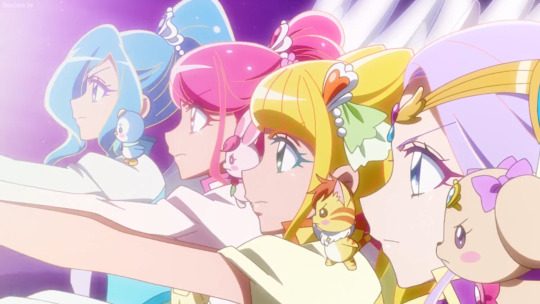
*sigh* Where do I start?
Well, one thing I’m pretty sure of is that COVID definitely affected production somehow. By that, I don’t just mean the show needing to go on hiatus, resulting in a shorter run compared to previous seasons. I’m also talking about any possible changes that might’ve been made to the original narrative, if there was one.
Much like how Suite’s story had to be altered in the wake of the 2011 Tohoku earthquake and tsunami disaster, I believe Heal underwent a similar treatment in response to the pandemic becoming more widespread as 2020 went on.
Especially since it dealt with health and nature, HealPre is probably the season that has come the closest in relevancy to real life events.
Frankly, that can be quite scary because this virus was and is still a fucking nightmare on a massive global scale. From that view, I can understand why the writers/producers would be concerned of the anime hitting too near home. At least for their main demographic’s (children) sake, maybe they were compelled to shift to something lighter and less edgier so that the kids could find some comfort and enjoyment in the midst of the world’s current crisis.
So I can’t fault Toei for that, if that’s really the case. Going through a pandemic is terrifying, infuriating and exhausting and UGH. We could use something that can help ease our worries or momentarily distract us even a little bit.
Though would it have killed them to dedicate one episode to the importance of wearing a mask or washing hands? (-_- ;;)
HOWEVER! Seeing as I am not a fragile child, I’ve still got several (oho~) criticisms to air out before I put this season behind me. This review isn’t particularly scathing but...there is a lot of discontent so you’ve been forewarned.
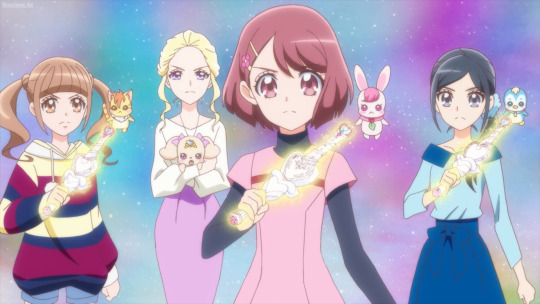
But first, let’s tediously review what structure means in Precure.
We all know that there are certain things that will forever (?) remain fixed in the series formula.
The plot is always going to be “magical girls fight evil doers threatening to ruin the world”.
There are plot points to indicate story progression but in reality, are put there to correspond with toy releases which are usually marked by these five: introductions, first power up, midseason Cure, second power up, and build-up to the climax + finale.
There is usually a specific message (a theme) to be told with every season and motifs (narrative tools) to aid in getting that across. For HealPre, the theme is “living is fighting” and its motifs are “health” and “nature”.
I left out “animals” b/c 1) it didn’t hold as much significance as the other two did, 2) animals are part of nature anyway and 3) let’s be real, it’s just a synonym for “mascots” which we already get every year. :P
Right. I’m probably forgetting something but for the most part, these are immovable pillars of Precure.
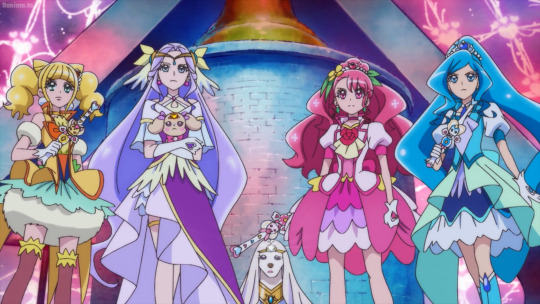
Story, on the other hand, has more variables you can work with.
Story is how you tell the plot, how you convey the message.
Precure, as a tv series, is unarguably carried by its main stars, the Cures. So it only makes sense that a huge percentage of a season’s success owes itself to how much of an impact its characters had on the audience as well as how effective their individual story arcs were as sub-plots tying back to the bigger picture (the message/theme).
Ideally, these arcs would shine the brightest in the filler episodes, where the plot (“good guys vs. bad guys”) is less of a focus so there is more space for personal development and growth.
Also, not all character arcs have to be directly related to the plot but they ought to be written well in order to support the overarching message (the theme).
Now, has HealPre done that? Has each girl’s story demonstrated a good example of what “living is fighting” means?
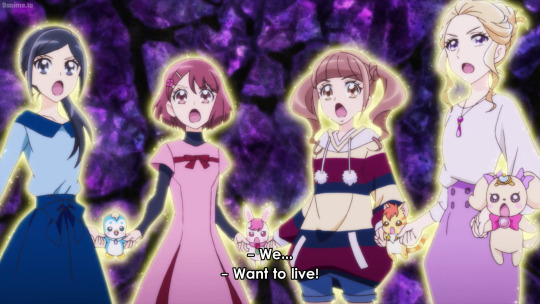
...nnnnnnyyeeee... look, even I can’t give a straightforward answer on that because while technically they did, by virtue of Nodoka’s observance in ep 44 recounting it as such, there’s also actually not enough to make it feel substantial from a viewer’s standpoint.
At least, that’s what I thought while watching HealPre.
With the exception of Nodoka’s, there was a lot of saying but not much doing to convincingly back the other girls’ arcs up. The fillers themselves were very weak, loosely composed in relation to the motifs and, if I may be so blunt, downright boring that if Nodoka didn’t phrase those episodes as things that counted towards the theme, I probably would put up more of a fight on disagreeing. so shoot me, I’m soft for her :P
And I know that sounds confusing right now but I will elaborate as I continue.
Before that though, to be utterly fair, some seasons keep their respective themes shrouded in vagueness until they’re given a more concrete form in words around the finale. So it’s not like we can do much except make educated guesses on what they really are. Most of the time, we’re just measuring everything against our perception of a standard in the fog. Or maybe that’s just me?
Nevertheless, you can just tell, y’know? By simply watching and observing the whole show, you can tell if the characterization, the development, and the outcome (essentially the content given) really live up to what the season claims is endgame.
So let’s go through that first then. The characters, starting with our lead Cure...
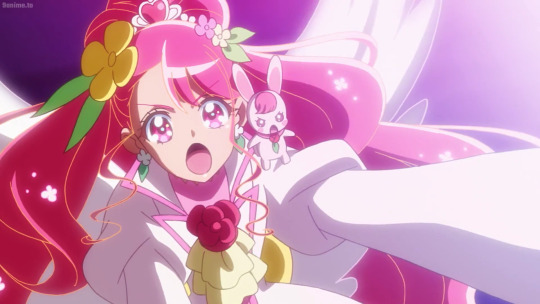
Nodoka being the only Cure in her team to have an arc deserving of the praise “exceptional” should come as a surprise to no one.
She was the most solid in terms of direction on how her story was going to proceed. Out of all the girls, her journey had the greatest connection to the subject “health”, repeatedly delved into it every time the spotlight was on her and fulfilled everything it seemed to promise from her debut in episode 1.
Her struggles on the road to recovery from a long-term illness and the strength she’s drawn from that traumatizing experience as well as her time as Precure did more than establish her as the strongest character in HealPre.
She has also rose to become one of the most memorable Pink Cures in the entire franchise (personally, I rank her in the top 5).
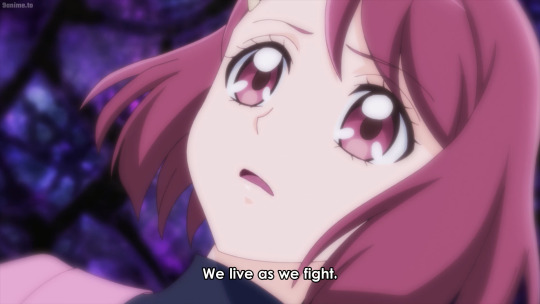
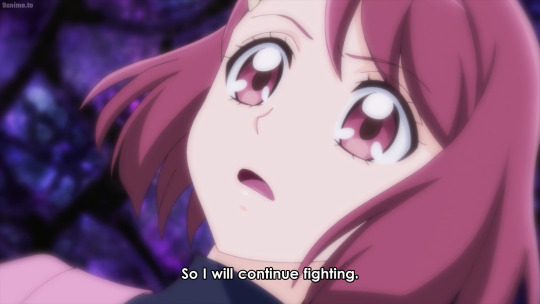
And it’s not hard to see why she’s earned such high regard in a lot of fans’ hearts.
The writers clearly worked a lot on her character composition to the point where she can pretty much embody the theme of “living is fighting” all on her own.
She came into HealPre fresh out of the hospital and full of earnest desire to make the most of her newfound freedom but she also wasn’t without knowledge on what hardship is. From there, she only got stronger, even when she was stumbling and trying to figure things out along the way. She grew more fortified in her beliefs on what it means to be truly live a healthy life.
She bravely defied the ones who attempted to take advantage of her and twist her cause against her. And she learned that taking care of herself is equally as important as wanting others to be safe from harm.
It was never about winning or coming out on top. It was about protecting a fundamental yet precious truth. That one thing any decent human being should never have to concede: the right to live well.
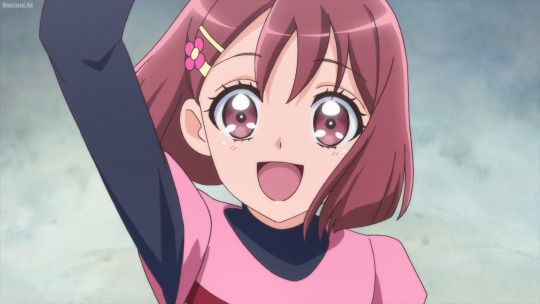
Honestly, Nodoka is absolutely inspiring all around, as a fictional character, a heroine and a normal everyday person.
Everything about her arc went satisfyingly right like it was meant to and the best thing is, we don’t need to question it because we saw how it all happened with our very own eyes.
I sincerely wished I could say the same for the others but sadly, they were just too flawed.
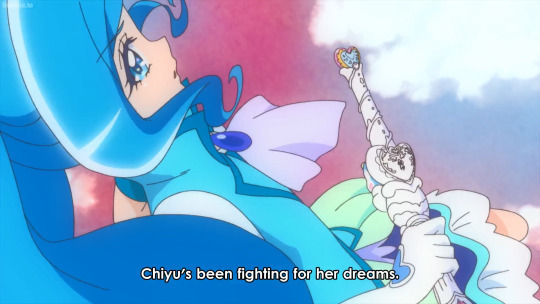
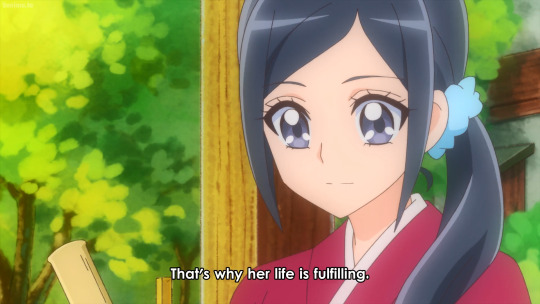
And Pegitan can throw flippers with me all day if he wants but as undeniable as the above statements are about Chiyu, her arc failed to leap over the increasingly mounting disappointment I had with every episode that’s been assigned solely to her.
Two of which weren’t even about Chiyu. One centered on Pegitan’s admiration for his partner and the other focused on her brother, Touji. Which, while nice to give to supporting/secondary characters, is a fat waste of valuable screentime and not what I’m here for.
It also didn’t help that the conflict of her arc (the indecision over choosing between two dreams) started really late in the game and was resolved so quickly within two episodes. There was no time for me to get invested into it, there was no powerful sense of conviction like how Go!Pri or Hugtto handled theirs and really, it just felt like Chiyu was only following what the script dictated for her rather than genuinely awakening to her own competitive passion towards track and field.
It was almost like it didn’t matter. Almost as if the writers procrastinated in thinking up something worthwhile to further her development...but then settled on grabbing an old idea off the shelf without refining it to suit Chiyu when they ran out of time.
This happened similarly with Minami in Go!Pri and Elena in StarPre, both of whom left me angry at how their arcs were executed. Yet theirs don’t compare to how pissed off I am about Chiyu’s. Because while Minami’s took a while to arrive, it wasn’t done poorly and linked back to Go!Pri’s theme well enough. And while Elena’s was over crammed last minute, at least it was unique to her character and had lots of potential ways to play out if they actually started it earlier on in StarPre.
Chiyu’s arc is like a discount version of the former with hardly any of the intriguing qualities of the latter. Sure, she had two early episodes that laid out the two most important aspects of her life (her family inn and her dedication to her sport) but after that, they weren’t brought up again until we were only weeks away from the ending. Y’know, just to fill up episode slots and meet the minimal requirement of saying they did give Chiyu some issue to resolve.
It was not engaging at all.
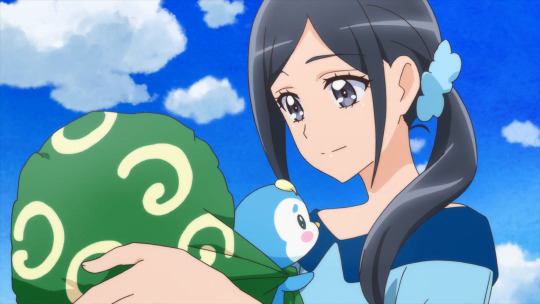
Furthermore, the fact that her arc had very little to no relation with either “health” or “nature” hurt my appreciation of her character somewhat. I just...don’t think her kind of story really matches with the central topics of HealPre?
...but maybe I’m being bitter about this all wrong and that’s screwing up my rational thinking on this matter.
Because Chiyu’s arc is valid under the logic of the overall theme, I would never say it isn’t. And again, character arcs don’t have to be close to the plot nor is it necessary to employ the “suffering builds character” method to make them interesting.
Chiyu always does her best every day. That’s sufficient argument on why her story does fit within the frame of HealPre’s premise.
Guess I’ll just have to wrangle my resistance into acceptance somehow.
...still, her arc could’ve been done so much better than what we were given. Chiyu at least deserved that much.
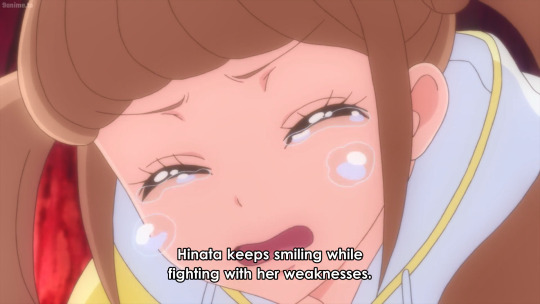
Next, Hinata.
Since the beginning, I knew she was gonna be runner-up to Nodoka for having the (for lack of better term atm) “best” arc because it was heavily implied that she has ADHD and therefore, immediately checked off the “health” trait. She was even more obvious about it than Nozomi was.
Difficulty paying attention, hyperactivity, impulsiveness. Hinata didn’t just display all those signs, she also showed how hard it was for her to deal with the downsides to them on a regular basis.
She kept apologizing and put herself down excessively for inconveniencing her friends even though they never blamed her for her condition. Got them annoyed a few times, yes, but didn’t stop them from staying friends with her and definitely didn’t make them hate her either.
Everybody was understanding of Hinata...except Hinata because she always took her failures to heart and considered quitting several times to avoid the crushing dejection of making mistakes over and over again.
She got better, though, and no one could have summed it up more heartwarmingly than Nyatoran with the encouraging words he gave her at the conclusion of her arc.
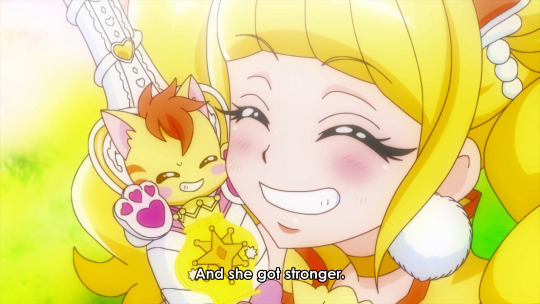
But it still feels like there’s a huge chunk of development missing between the start and finish. Or rather, it seemed like all of it occurred offscreen and we were only informed later that it did in fact, happen.
To recap, iirc, Hinata had around 5 episodes that focused on her (ep 9, 13, 23, 35 and 40). Ep 18 doesn’t count because that was a Nyatoran-centric filler more than anything.
Ep 9 and 13 did their jobs of introducing and highlighting the details of Hinata’s troubles while also suggesting she will eventually learn to overcome her insecurities. The ones after, though? They pushed those issues to the backseat.
In Ep 23, she had to share the (uneven) spotlight with Asumi. Hinata’s improvements were briefly mentioned but the majority of the ep went to teaching Asumi what “cute” meant and how to get along with puppies. I mean, I get that Asumi recently joined the group and bonding with her was mandatory by tradition. But since each Cure only gets a limited number of eps to herself, it would’ve been more beneficial for Hinata if she didn’t have to split screentime with someone else’s growth schedule.
Ep 35 is slightly better but not by a whole lot. Sure, Natasha was able to reconcile with Elizabeth which was very sweet and heck, it was the goal for that episode. But again, nothing was really done or addressed about Hinata’s main conflict. She tossed it back with the rest of her homework to deal with later. ahaha, a TroPre hint
Then ep 40 came to formally close the curtains on her story and apparently, Hinata screwed up lots of times since...whenever but she picked herself up every time after and kept on trying. Awesome. So WHY didn’t we get to see that?
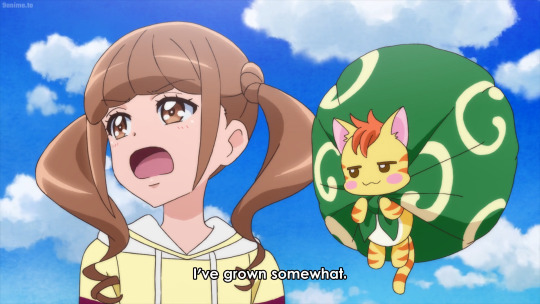
I’m not asking for the impossible here. I’m not asking for Hinata to be cured or anything miraculous like that. There is treatment available for ADHD but it is not curable.
Also, forcing Hinata to find a way to get better at studying, the thing she struggles with the most, is not the solution either because that would only make her more stressed and anxious over her own disorder.
What I want is to see how she moved from wailing “I can’t do it! I don’t wanna! I’m so scared of failing so why bother?!” to determinedly declaring “So what if I failed 1 or 100 times? So what if I fail another 1000 times? What matters is that I don’t let that stop me!”
That confidence is not something that can be built up overnight. It’s gradual and it takes numerous tries to reach from where Hinata was to where Hinata is now.
Telling me she grew emotionally stronger can only allow me to believe so much. I need to actually witness the changes as well.
If it weren’t for that, Hinata’s arc would have been a lot more impressive. Shame.
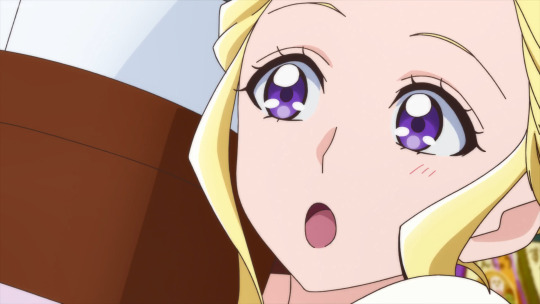
Finally............... Asumi.
Asumi, Asumi, Asumi, Asumi, Asumi, Asumi, Asumi... *sighs & drums fingers*
...she has no arc, ok? Seriously, what story is there to speak of, much less write a hefty analysis on?
A spirit born for the sake of Latte who just went along with the Precure ride because Latte didn’t want to abandon her duty. She made friends with those who aren’t Latte, extended her knowledge and understanding and gained valuable human experience during her stay on Earth. But ultimately, she will always define her entire existence around a puppy.
Nothing is more important than this puppy.
...... to be honest, Asumi not having a storyline isn’t what bothers me. It’s her lack of depth that does.
Hell, even the giant burger she ate had more depth than she did!
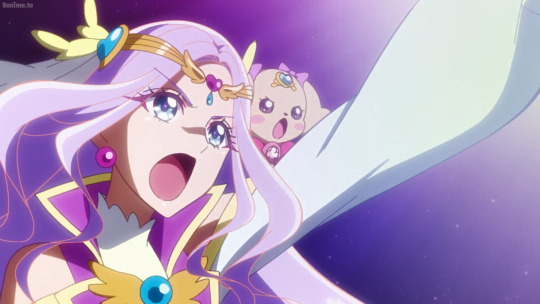
Oh, Asumi does have a personality alright. She’s consistently and unfailingly polite, utterly devoted to her raison d’être and in crucial moments, gives pearls of wisdom when the girls are in a pinch. She’s good.
But if that’s all she is, then she’s also painfully dull.
She has nothing to contribute to the discussion of health or nature, despite being created through an element of the Earth so you’d think she’d have an opinion of her own. At least worry about the planet that gave life to her as much as she frets over Latte all the time. But nope.
She shares the exact same face as Teatine’s past Precure partner so you’d think we’d explore that connection to see if it would influence or affect her in any way. But nope.
90% of the time, her role was just being Latte’s constant, fawning satellite.
Not only did that irritate the hell out of me but it just reinforced my stance that this type of character is one of the worst you can ever insert into any narrative.
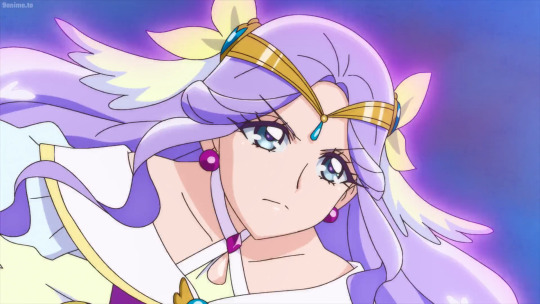
Because if someone keeps reiterating how much they’re obsessed with this one thing and seldom talks about anything else without bringing their obsession into it... then what’s so special about them on their own?
You’ve practically surrendered the different qualities you could have had for worship of something else. That’s not a fair trade-in.
Asumi’s character is so packed with Latte-related stuff that there’s not much space left for anything that can be considered uniquely Asumi.
I mean, maybe it’s because I can never see myself or any normal person comfortable with living like that.
Living for the sake of being together with the one you love? Okay. But living with your whole universe revolving around that one thing? Making most if not all decisions based on this one thing?
No. That’s absolutely crazy, alright? Nobody with a healthy amount of awareness and self-worth would live like that.
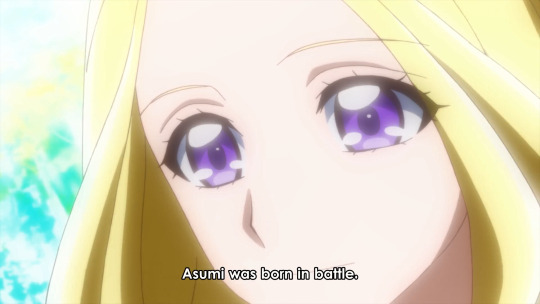
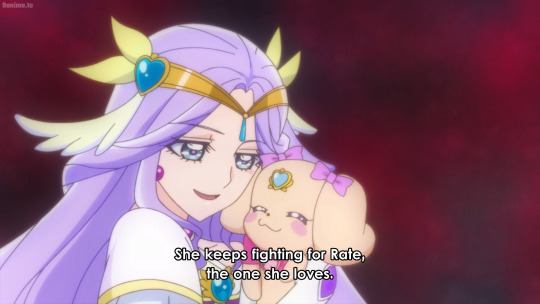
And you can counter that Asumi’s just born like that. That she can’t help her origins because Teatine’s wish to protect her daughter is essentially what brought Asumi into existence so of course, her biggest concern would be Latte. At least, she wasn’t forced into it, right? As long as Asumi chose of her own will to follow Latte, it should be fine, right?
You can even use the fact that Asumi isn’t human. That she’s a spirit and we shouldn’t apply our human standards too strictly to her.
Yea, but those are feeble defenses in the face of her being a good main character, a good main heroine.
There are many ways to make a decent MC. The way Asumi was written proves she certainly does not possess traits that can classify her as true protagonist material. A protagonist has to be more than one amplified feature, which Asumi is not.
For the record, I don’t hate Asumi (she’s not interesting enough to generate a feeling that intense). I'm just severely let down because even if I don’t end up loving the midseason Cure for whatever reason, I can usually count on them to bring something intriguing to the table to dissect and analyze. At least I should find something to care about them.
Didn’t happen with her. :(
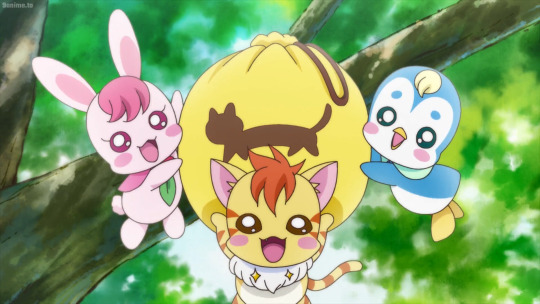
Oh god, I’ve been working on this post for days now and I’ve got a headache and with the baton pass happening in less than a few hours as I type this, I just really need to get it done and over with so please forgive me for speeding up through the rest, I’ll try to keep it as coherent as possible. NYARGH! (@_@ ;;)
Mascots.
Would you be surprised to hear that I’m not surprised that they were actually written very well?
Like I said early on, I suspected the return of fairy partnerships were going to improve the mascots’ significance in the story and, well, I was right.
This time, they didn’t just fill in the usual expectations of relaying exposition, serving as the Cures’ transformation devices and looking cute for the merchandise. The Healing Animals had to make progress on their own training to become doctors as well.
And they did through their relationships with their human partners.
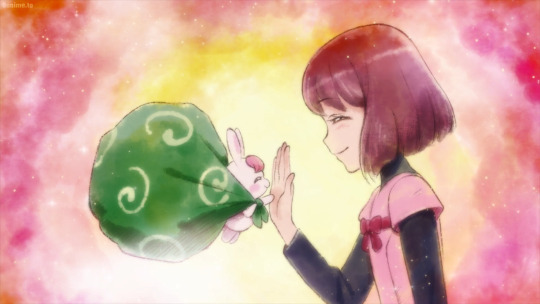
It was a refreshing take on the mascot aspect of the series because the friendships felt really symbiotic. When the trainees arrived on Earth, they relied on the girls to help them perform their jobs as well as provide them with shelter, food, the occasional peptalk about their trainee status, etc.
Then as the story continued and they got to know each other better, the mascots were able to return the favor by giving support when the Cures needed it. Rabirin when Nodoka was frightened and confused about how to deal with Daruizen, Pegitan when Chiyu was having trouble choosing between two dreams and Nyatoran who made sure to always lift Hinata’s spirits up when she got upset at herself.
In short, they achieved their objectives of learning what it means to be good doctors by being there for their friends! How wonderful! :D
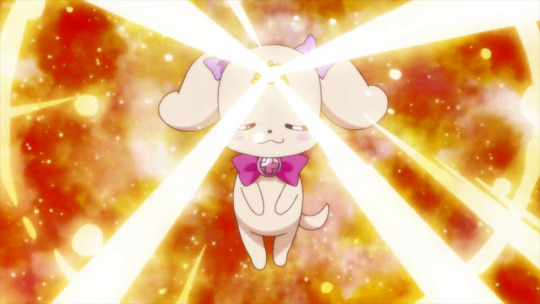
My memory for Latte is hazy, unfortunately, since she’s coddled by everyone all the time (can’t blame them, she’s friggin’ adorable! <3) but I’ll never forget how she stood firm on the battlefield to see things through, to fight for the Earth like she promised her mother. She started out so babie but showed us all there was enormous bravery behind her cute face and ugh, we should all be very proud of her! <3
The only major issues I had about the mascots were these:
1) Too many irrelevant fillers went to them. They only needed a maximum of two for their entire mascot group.
2) Latte kept getting sick even after she acquired a Precure partner of her own. I was hoping it wouldn’t hurt her as much as it did before Asumi arrived or that she would build up a stronger immunity but noooo, they insisted on torturing the poor pupper! T_T
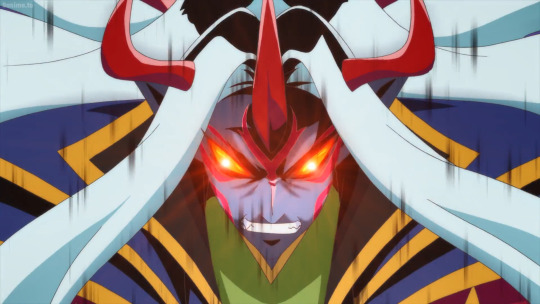
Villains + Finale Battle
Not a lot needs to be said for the first part. We’ve had mediocre antagonists before. HealPre’s just happened to be extra annoying as they were despicable.
Which is worse because jerks you can just leave in the trash but assholes won’t stop harassing you unless you pummel them into their graves, set fire to their corpses and leave no trace of them behind! >:(
Y’all know who I’m talking about. Opinions on him continue to vary depending on who you talk to and if they’re avid fans of his face or not but whatever. The son of a bitch served his purpose and is dead now. That’s all that matters to me.
Anyway, the King was flat like his two lesser generals. He was neither intimidating nor distinguished enough in the brand of evil to really make us think of him as a serious threat and because of that, it ended up making the boss fight look like any run of the mill boss fight.
I know, they tried so hard with all that shiny animation but it just didn’t have that glorious sense of vindication that previous seasons (or ep 42) gave and I blame it all on this Rumiko Takahashi reject.
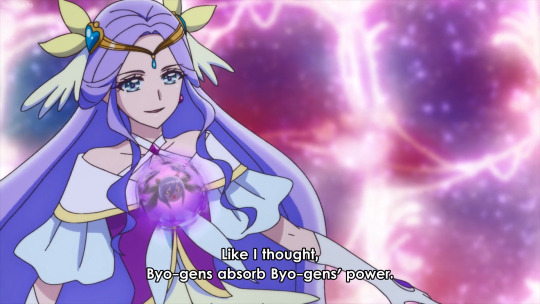
Also, this strategy was pretty useless?
They built it up like Earth was gonna sacrifice herself and die or something (she wouldn’t and even if she came close, deus ex machina would’ve kicked in to prevent that and COVID-induced caution too I guess).
But there were no signs of pain (well, that’s a relief) after absorbing Shindoi-ne and they really pissed King Byogen off more than they did any damage with the absorbed byo-gen power.
...so yea, this tactic was just to kill some time and budget, nothing more. Meh.
By the way, did Asumi eject Shindoi-ne’s pathogen out of her body yet or did they just leave it in there to bounce around until it eventually dissolves on its own?
Because that’s eww. I mean, it’s obviously not gonna hurt Asumi they can both relate on hyperfocusing their affection for someone so maybe the compatibility helps :P but still, ewwwww.
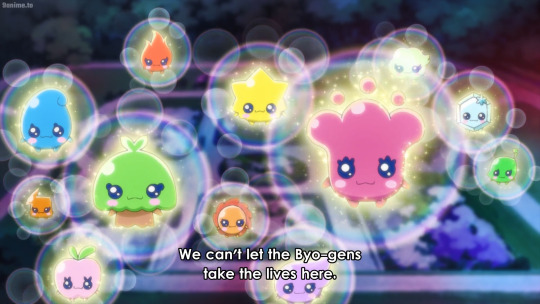
Fillers + Underused Motifs
In hindsight, perhaps HealPre didn’t exactly promise the content we I wanted about “health” and “nature” if their objective was to teach that any manner of “fighting” can count towards “living”.
......but fuck you Toei, you’re still cowards! >:/
Fillers will be fillers but it’s always better to try and make some of them as meaningful as possible. And they wasted the opportunity to inform an impressionable audience (during a very crucial period of our time, I must add) on a lot of things related to the HealPre’s motifs. Especially about the environment which for some ridiculous reason, they chose not to touch on for the main stretch of the overall story.
Proper hygiene, good diet plan and sleeping habits, regular exercise (already done by the girls a few times but could use another example), meditation, counseling/therapy (especially for mental health!), etc.
Real life pollution, climate change/global warming (IMPORTANT!!), deforestation, preservation vs conservation, endangered species, recycling, volunteering to clean up your community, etc.
These just came off the top of my head but yes, there’s more and no, I’m not saying that the writers need to cover all of them in extreme detail or replace the slice-of-life episodes.
But they should be able to mesh both serious and light-hearted together in harmony somehow. Like those fillers where the mascots saw people cleaning up littering at the park or that interaction with that arborist who taught them about wild animals and trees when the group went to visit a lake.
For health, maybe let the girls visit patients with chronic illness in the hospital or have them converse with a medical professional on some matter. Particularly if it’s got something to do with mental illness because stigma in Japan on those who are afflicted with such conditions is still prevalent and has caused a number of sad and shocking tragedies that could have otherwise been avoided if people didn’t have such outdated, judgmental mindsets.
That last part might be too dark for a children’s anime but there’s a lot more out there that is doable.
Do that without reducing it into a footnote, Toei. It is so necessary for your target audience to be aware of these issues at the age they are now. You have an almost 20-year old franchise to serve as a very effective platform. Make better use of it if you truly care about the message you’re conveying through your show!
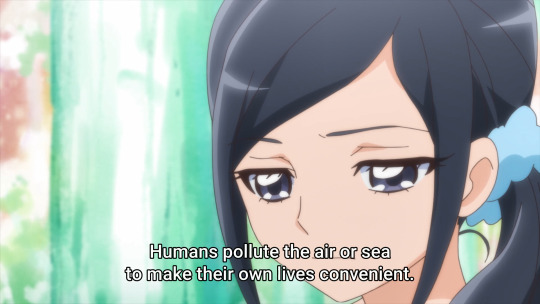
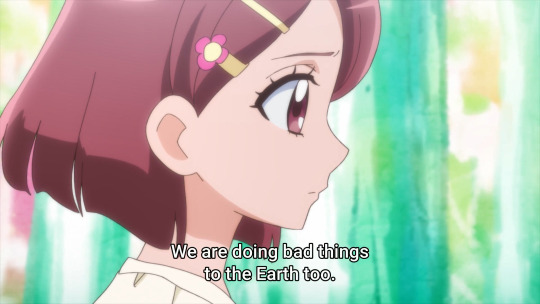
Also, what the fuck.
The last episode was a mess. Why are you only mentioning this now when the season is already over?
This should’ve been brought up months ago!
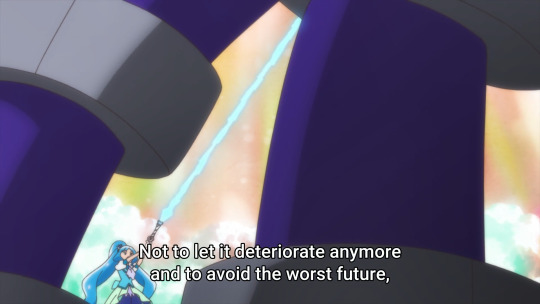
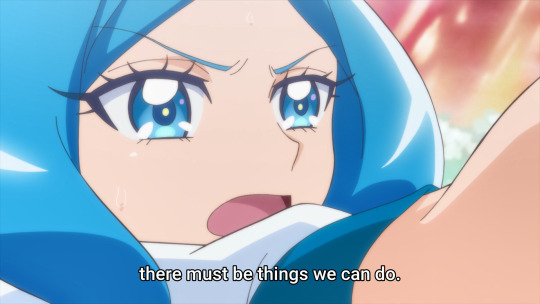
All the things we could’ve seen the Cures done to protect the Earth without magic.
The excuse of “I didn’t know humans were so horrible!” is a shit one because everybody knows humans are deplorable trash when it comes to abusing the Earth. All the more reason why you have to persistently drill it into people’s heads that they should not be like those who don’t care or choose not to care.
One crack episode isn’t going to cut that.
God, I so want to unsee this ep just so I don’t have to end HealPre on a more sour note than it already was. *big aggrieved sigh*
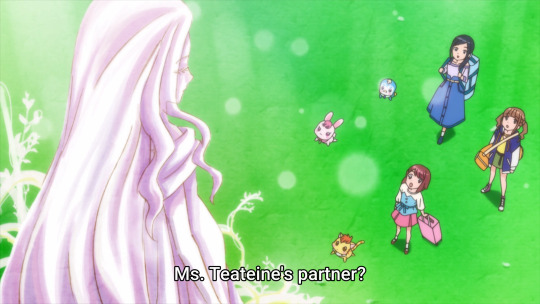
Lastly (and this really is the end of my long ranting, I promise), the missing undisclosed lore.
There are few Precure seasons without a past lore of its own in the recent years. Is it a wonder, though?
Lore is mysterious and fascinating. If it involves a past Precure, even more so.
Sometimes fans might just hang onto a show because they’re curious about what happened before the main story. We’d never get the full tale of those adventures but at least, it’s fun to imagine the “prequel”.
Also, past Precure are just badass. Fact.
Strangely enough, we didn’t get that for Heal. All we know is that she was called “Fuu” and was very close to Teatine.
Hmm. Probably one of those changes caused by COVID interference cuz I can’t imagine the writers choosing not to tell her past in the original draft.
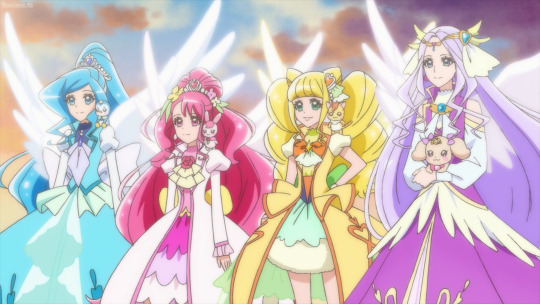
With all that finally off my chest, I’m ready to part ways with you girls until the next All Stars (Nodoka, I’m gonna miss you so much! T_T)
HealPre wasn’t the worst and it was nowhere near the best that it had the potential to be. But it’s passable. At least for those who loved it even with its flaws, I’m genuinely glad it was good for you.
For those who are thinking about picking it up (although why you would read this spoilery post before watching, I have no idea), if you’re looking for a standard magical girl anime to enjoy casually, then this is a safe pick. If you really want to invest your attention and heart into it, though? Then perhaps it would be in your interest to ask someone who saw it already to help you filter out the episodes that are worth watching. You don’t need to worry about the rest, they’re inconsequential. :P
Ok then! Thanks for reading as always, brave souls who have reached this point.
Stay healthy and safe out there and I’ll see you at the beach next week! Tropic underwater paradise here we coooooommmmmeeeeee!!!!!!!!!!!! xDDD
#i rage quit two drafts and an outline before i got anywhere with this#now if you'll excuse me i gotta catch up on my workout and play pokemon and eat pho later#and catch up on the ccs manga#livin' the healthy life oh yea~#healin' good precure#cure grace#cure fontaine#cure sparkle#cure earth#hanadera nodoka#sawaizumi chiyu#hiramitsu hinata#fuurin asumi#rabirin#pegitan#nyatoran#latte
10 notes
·
View notes